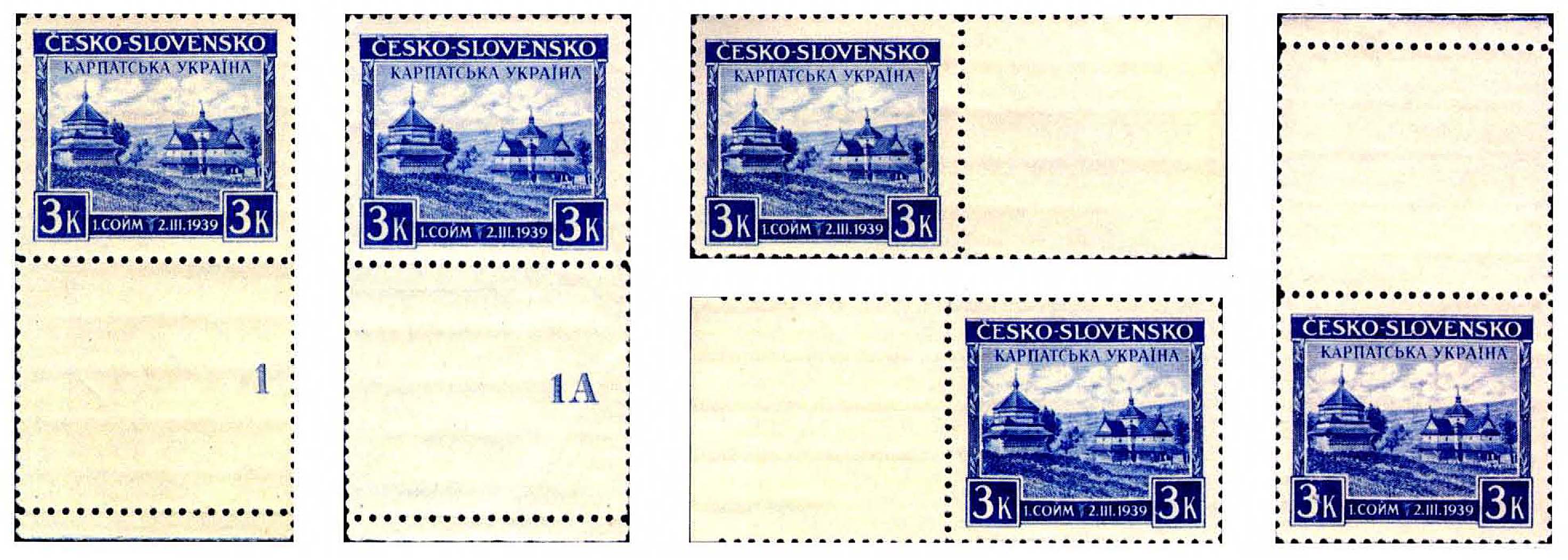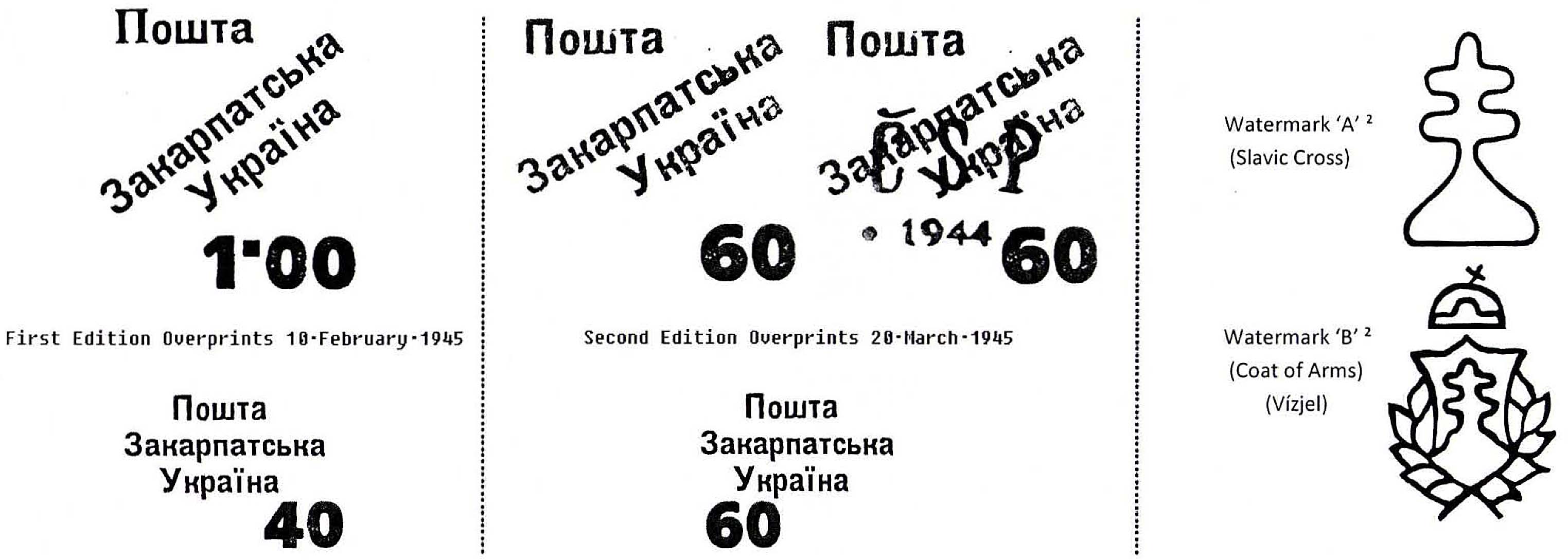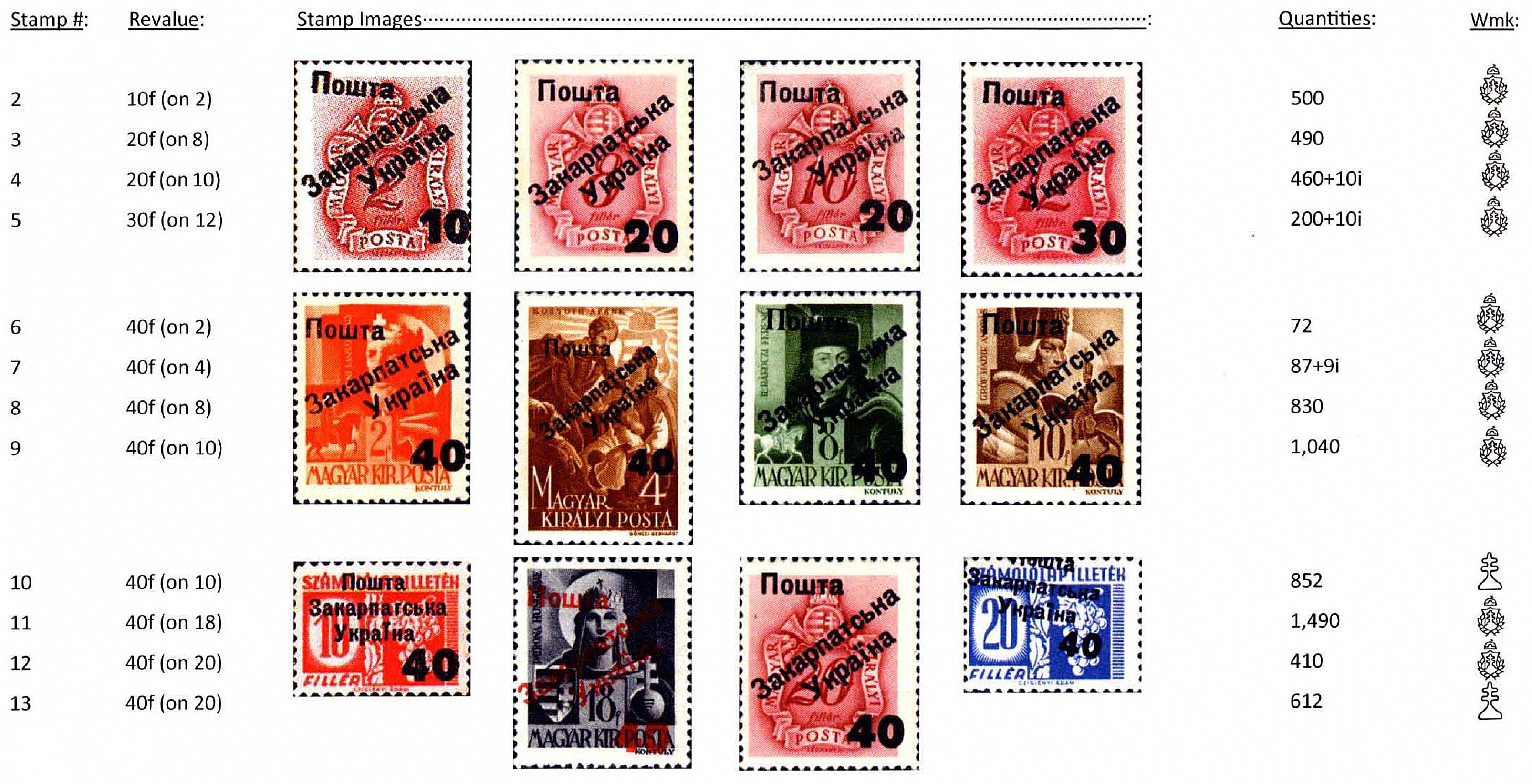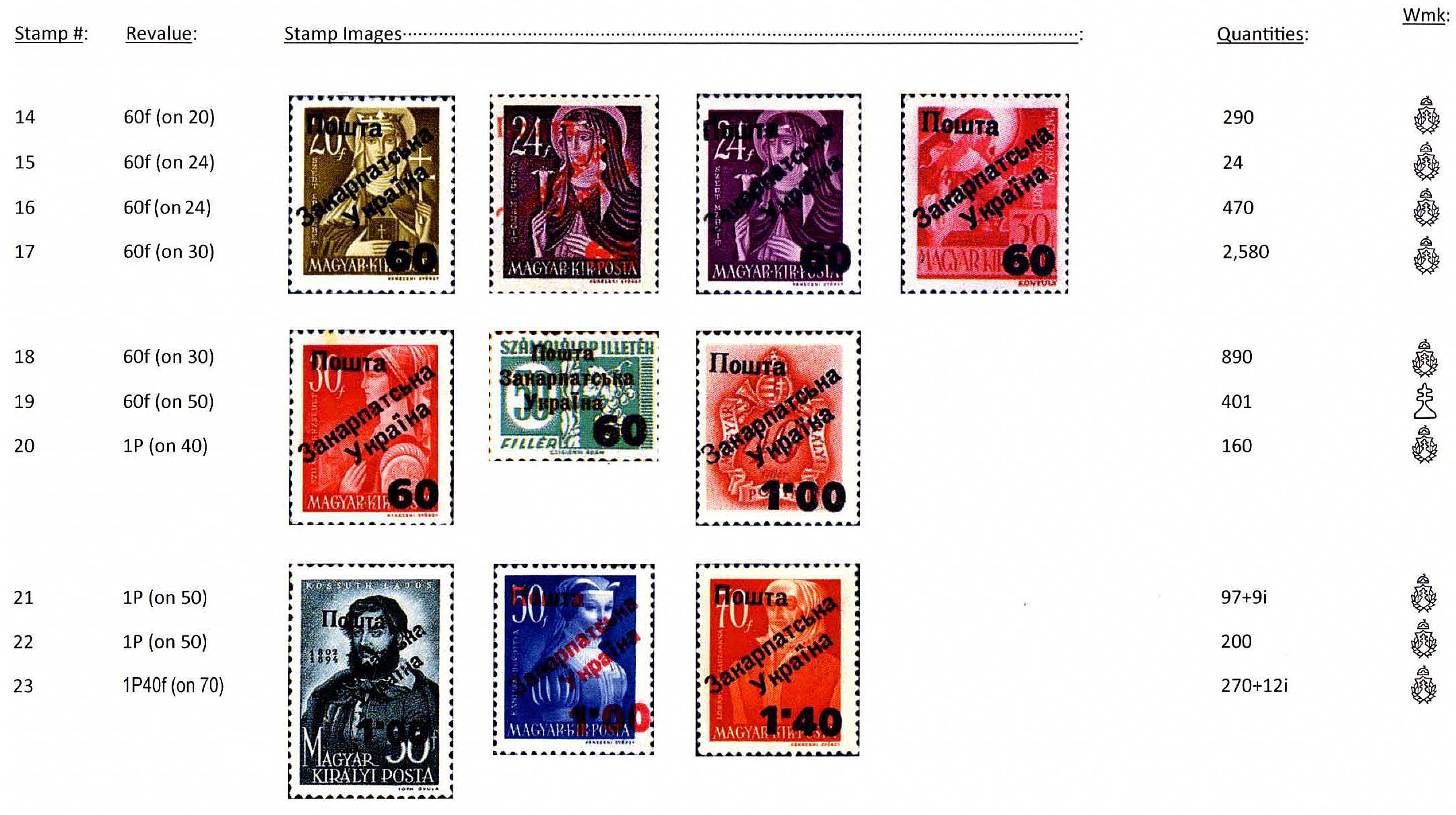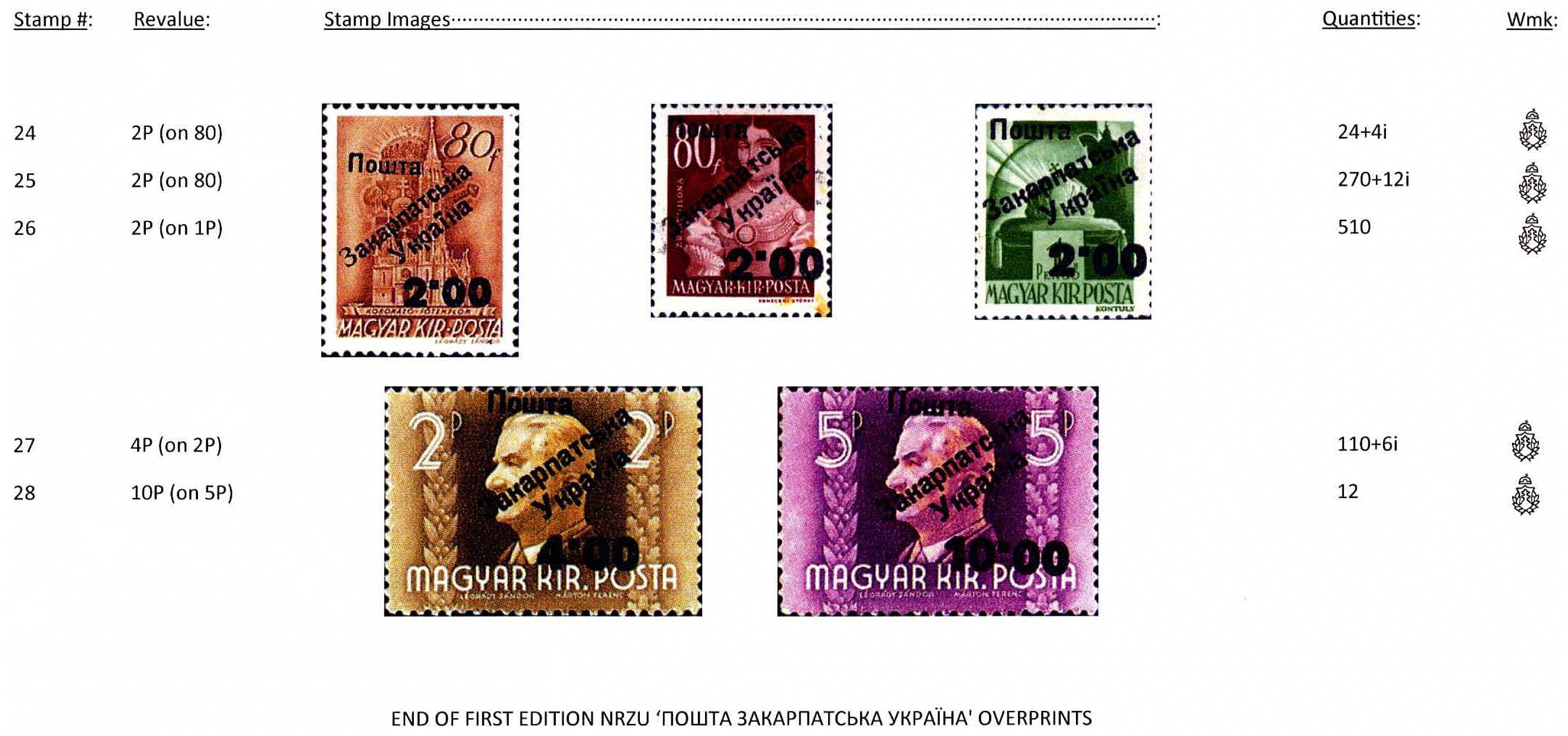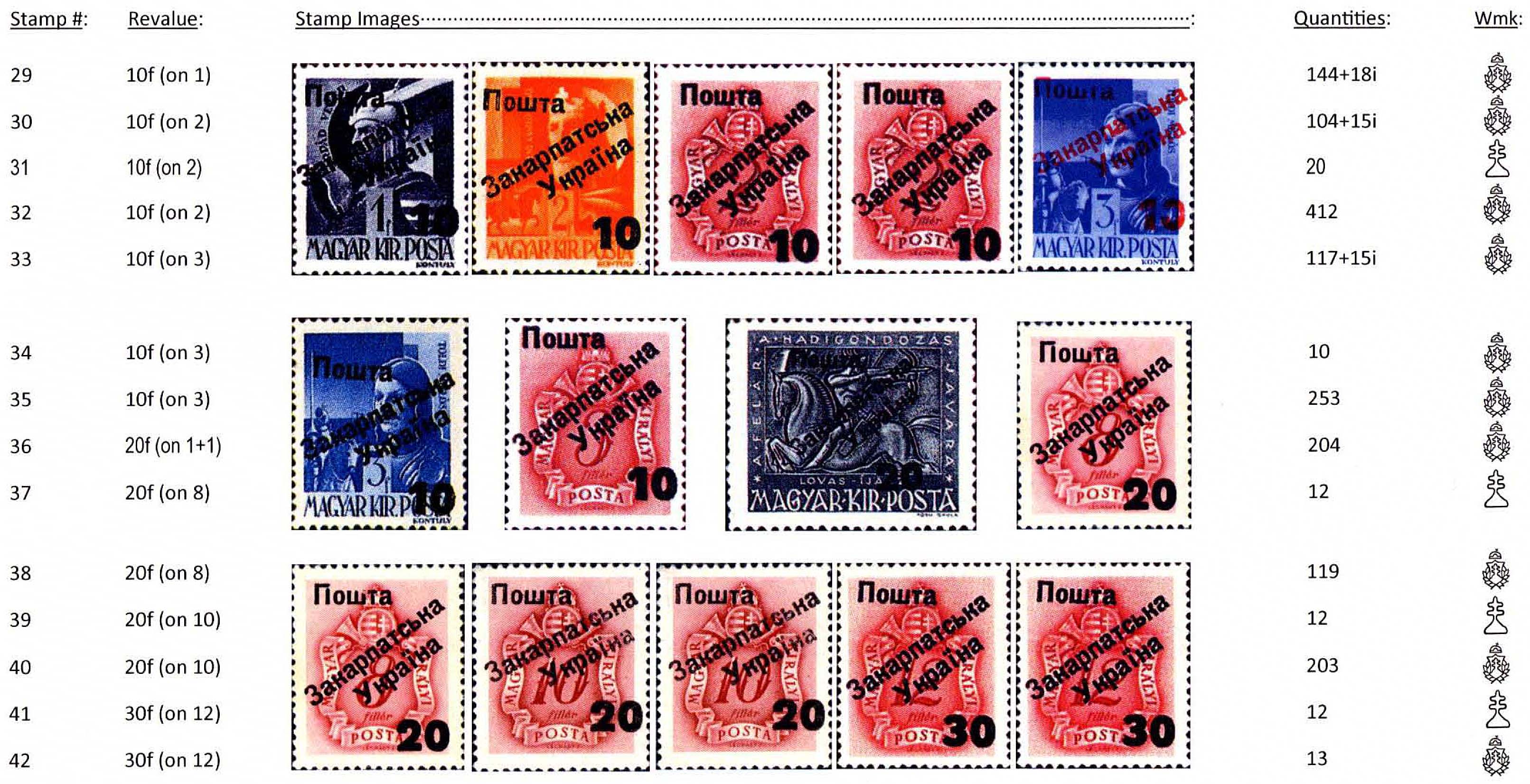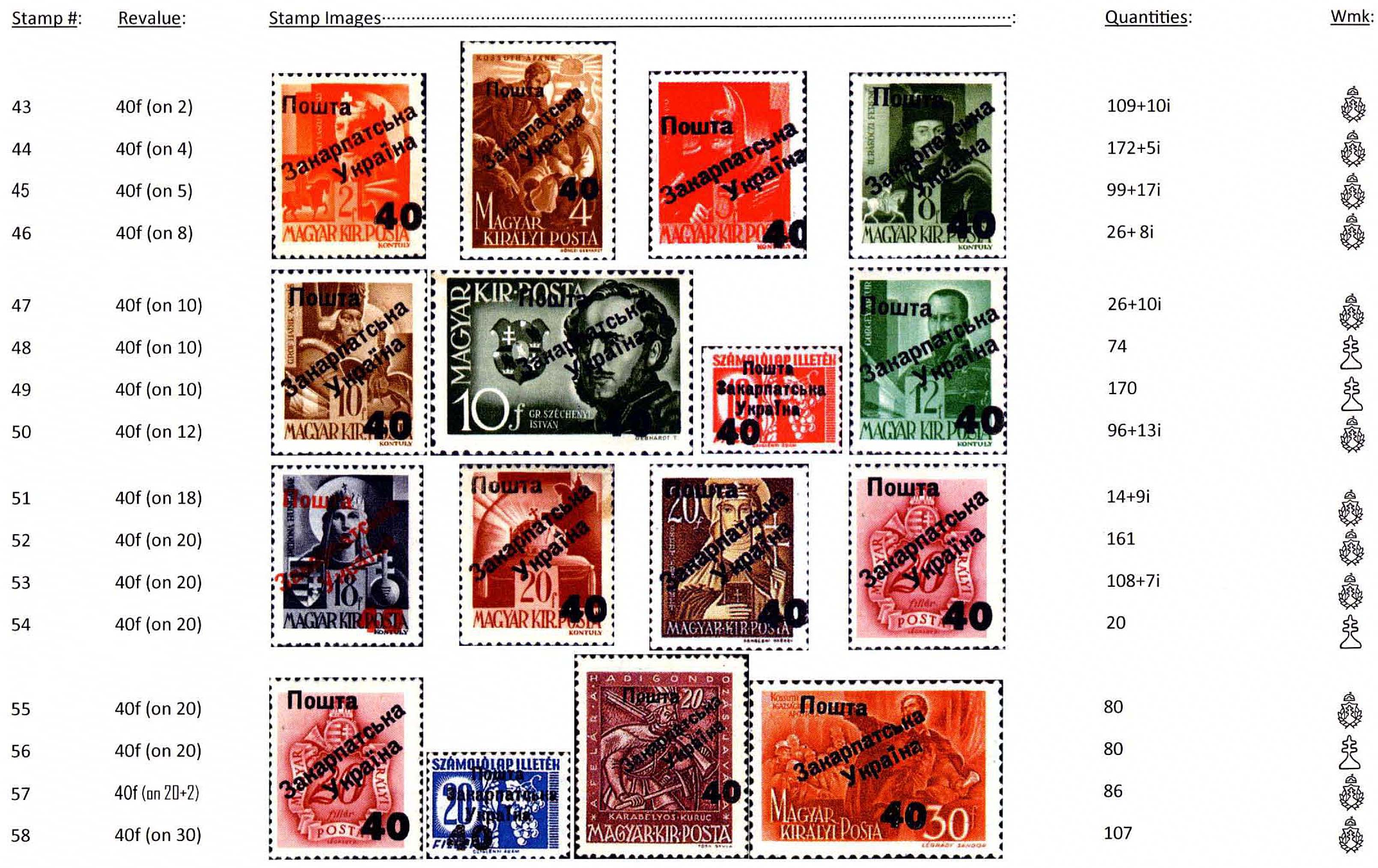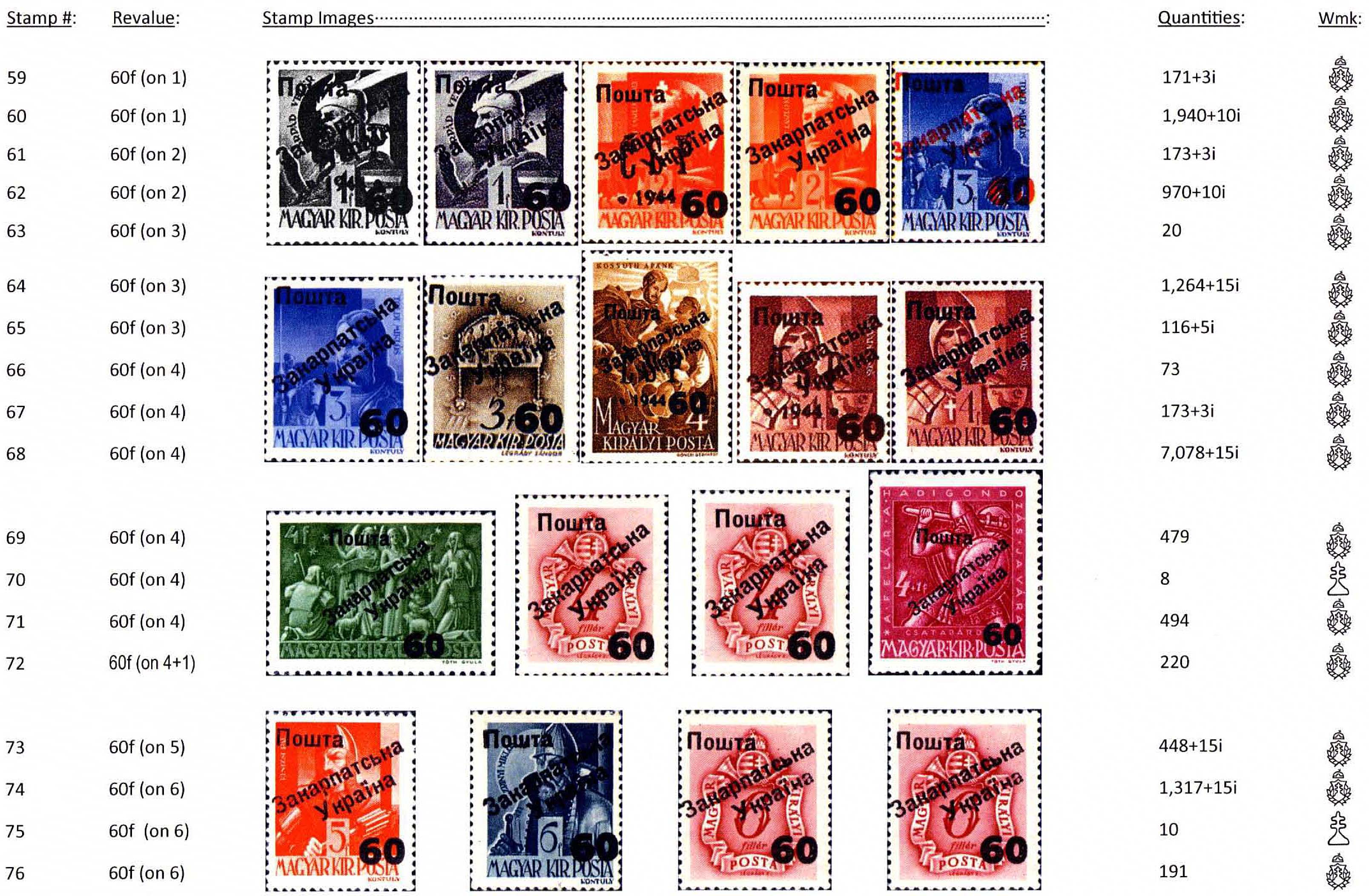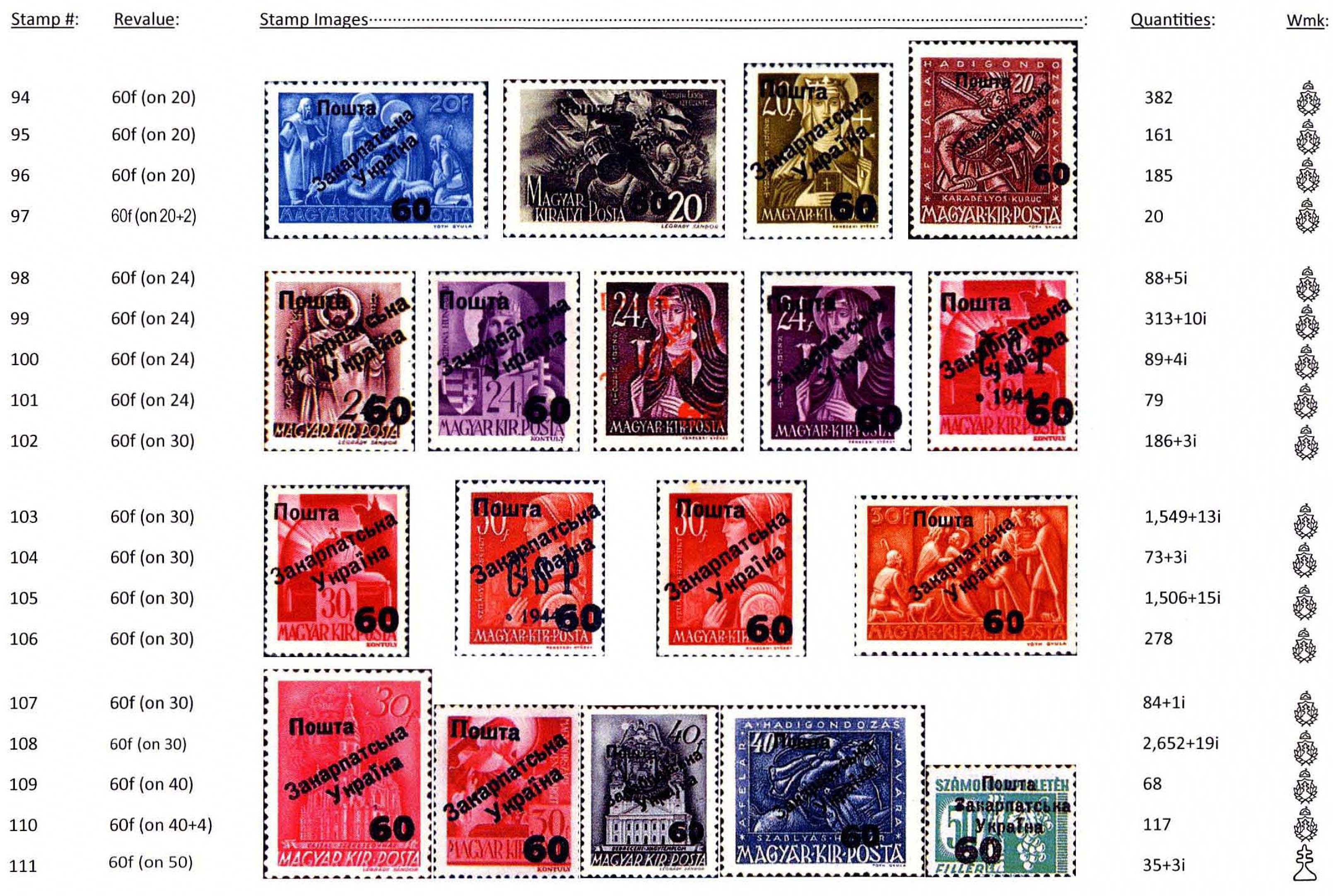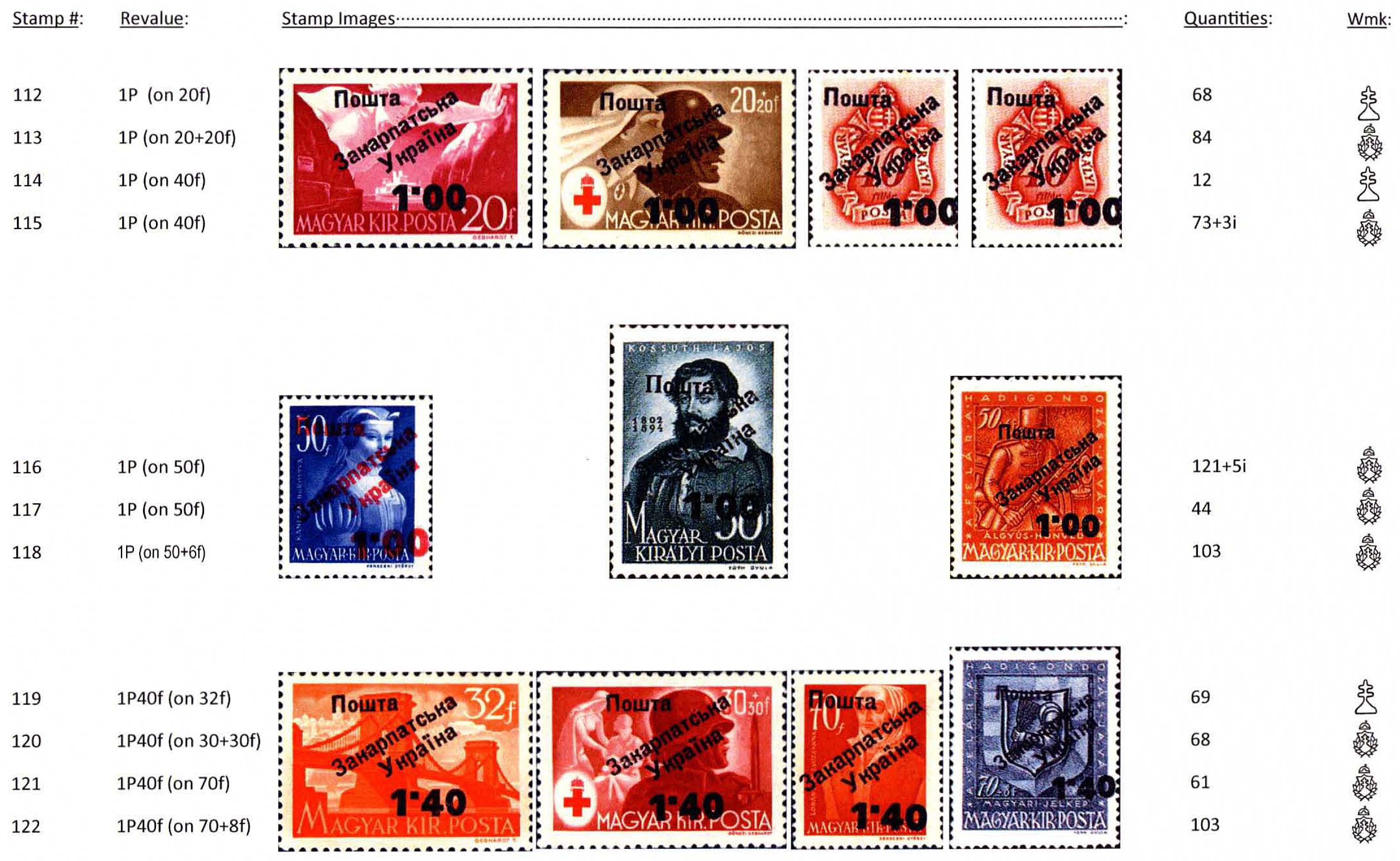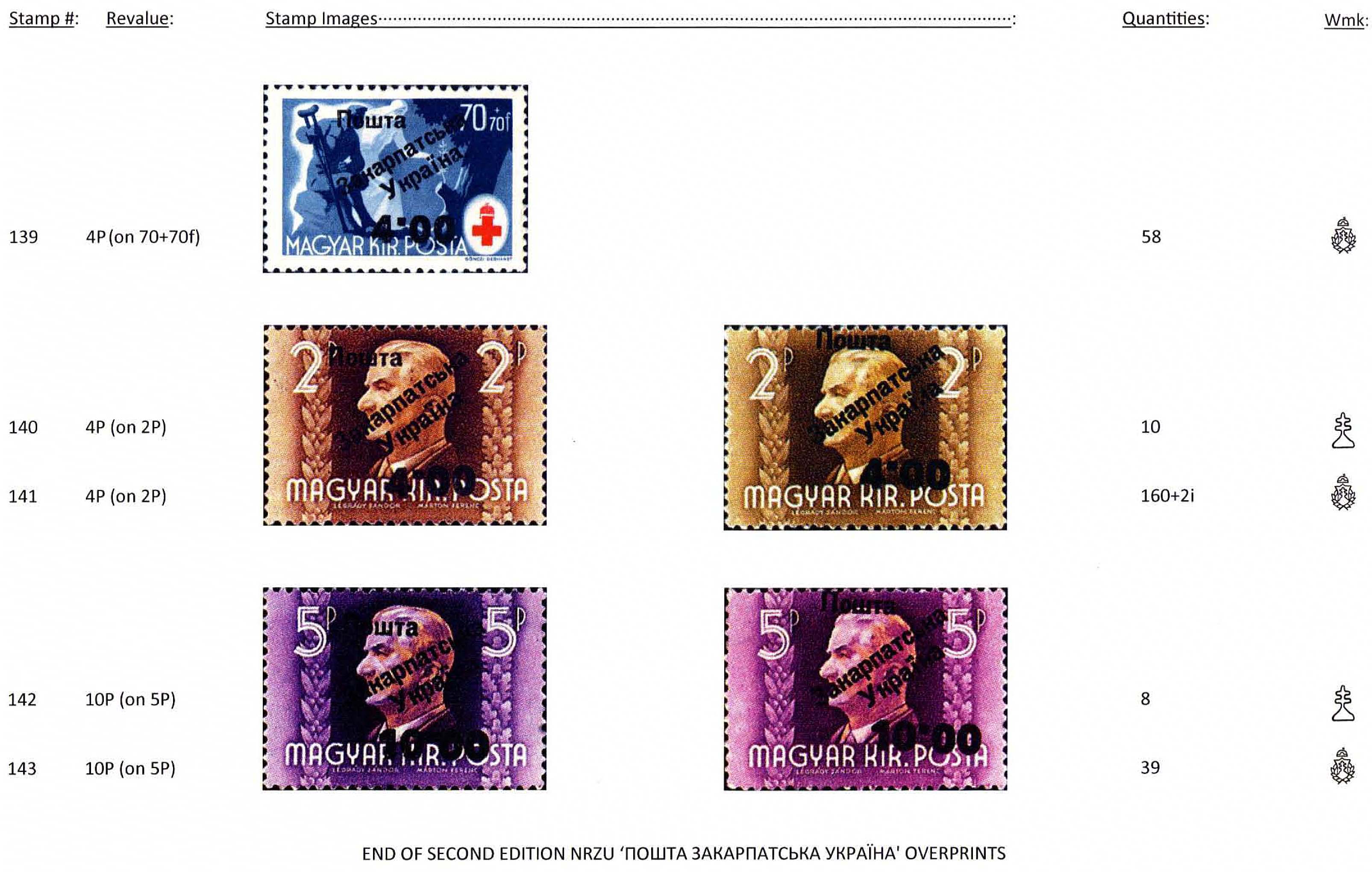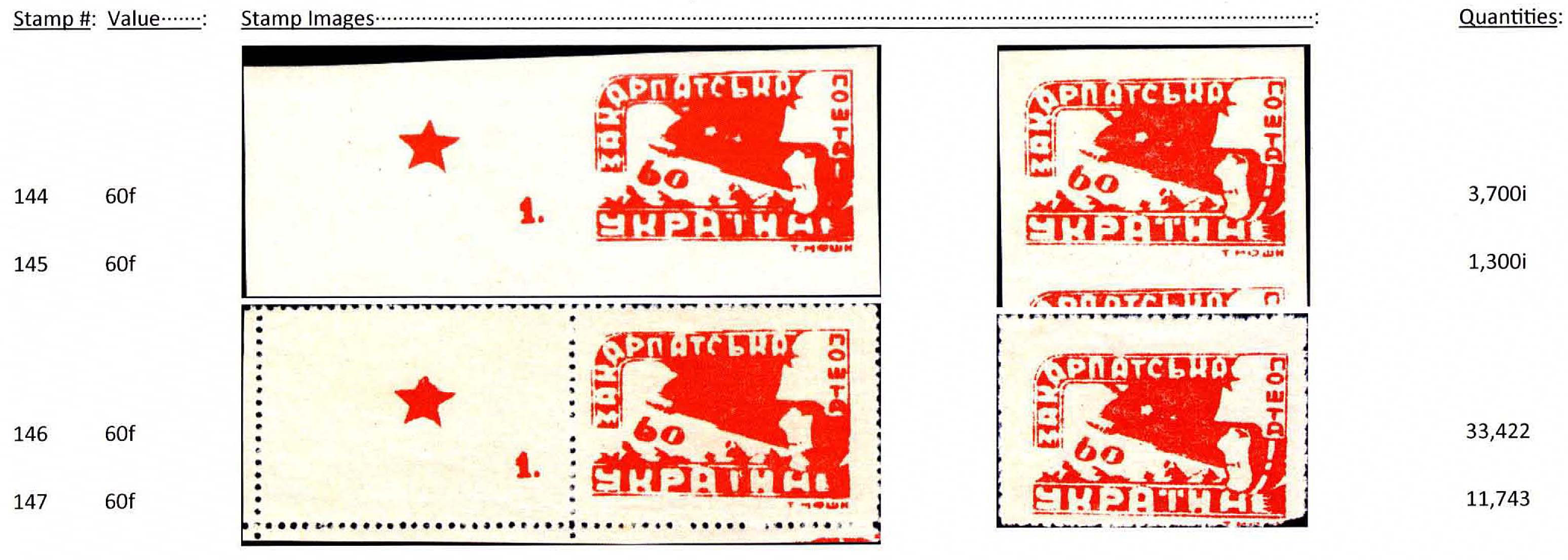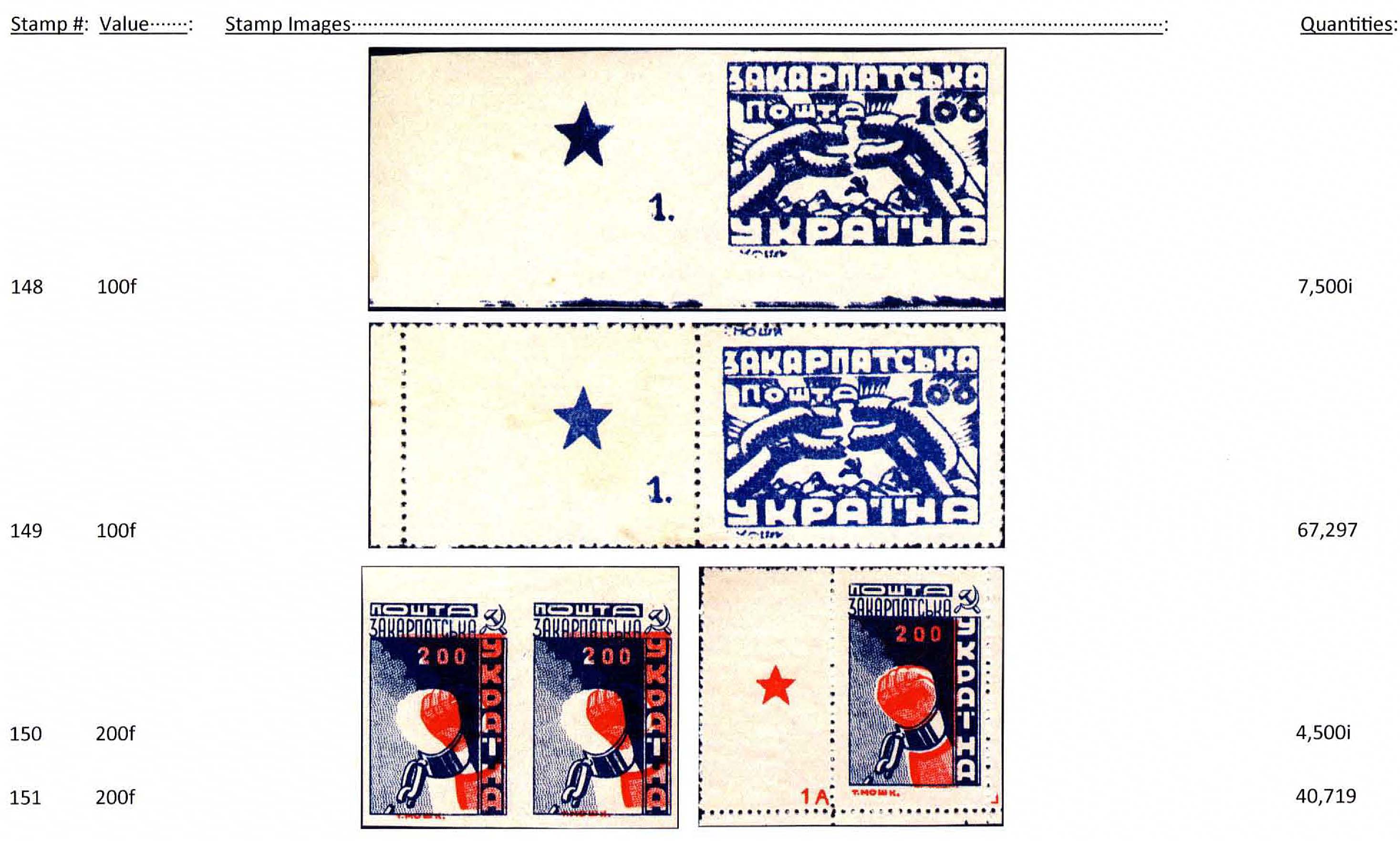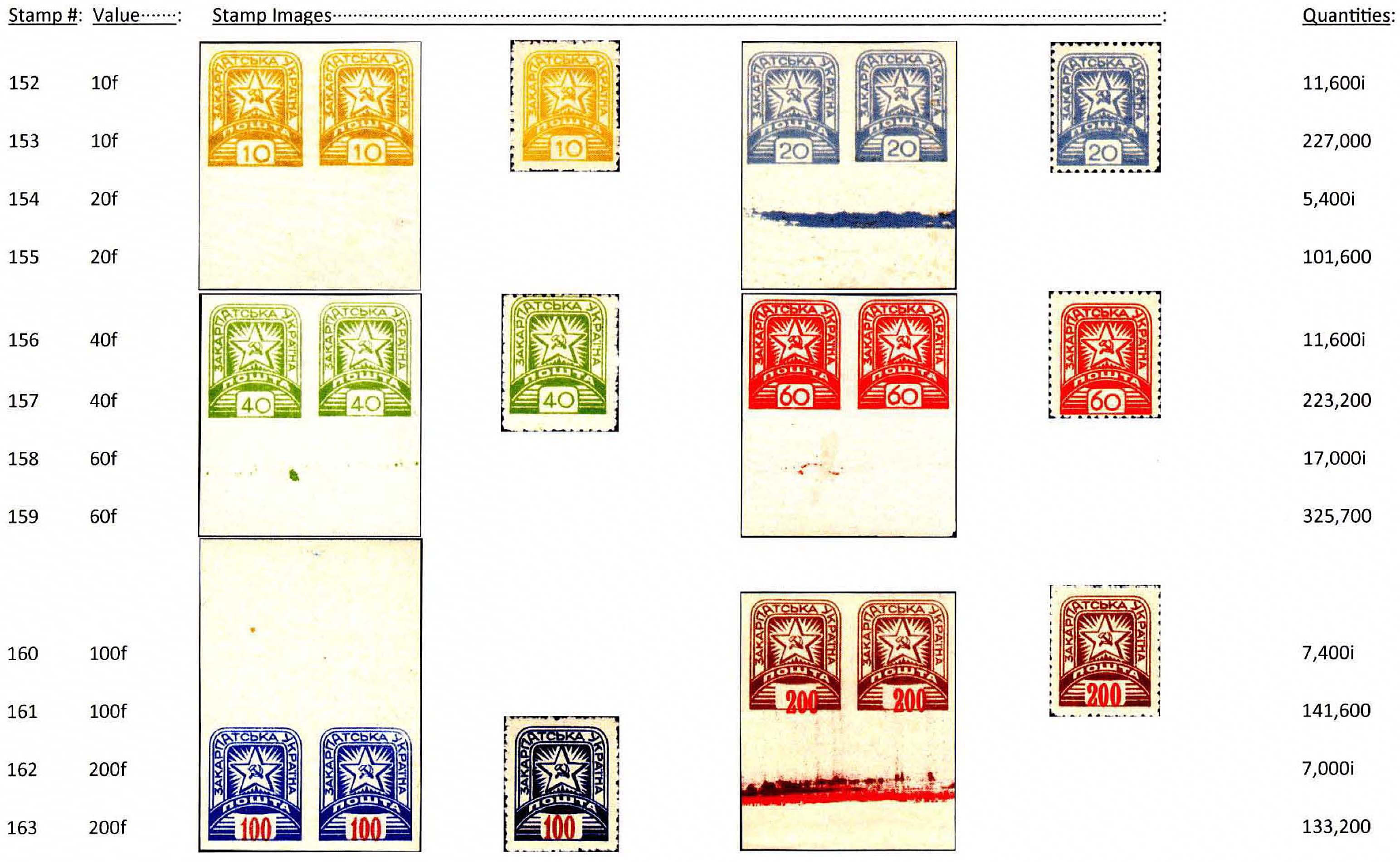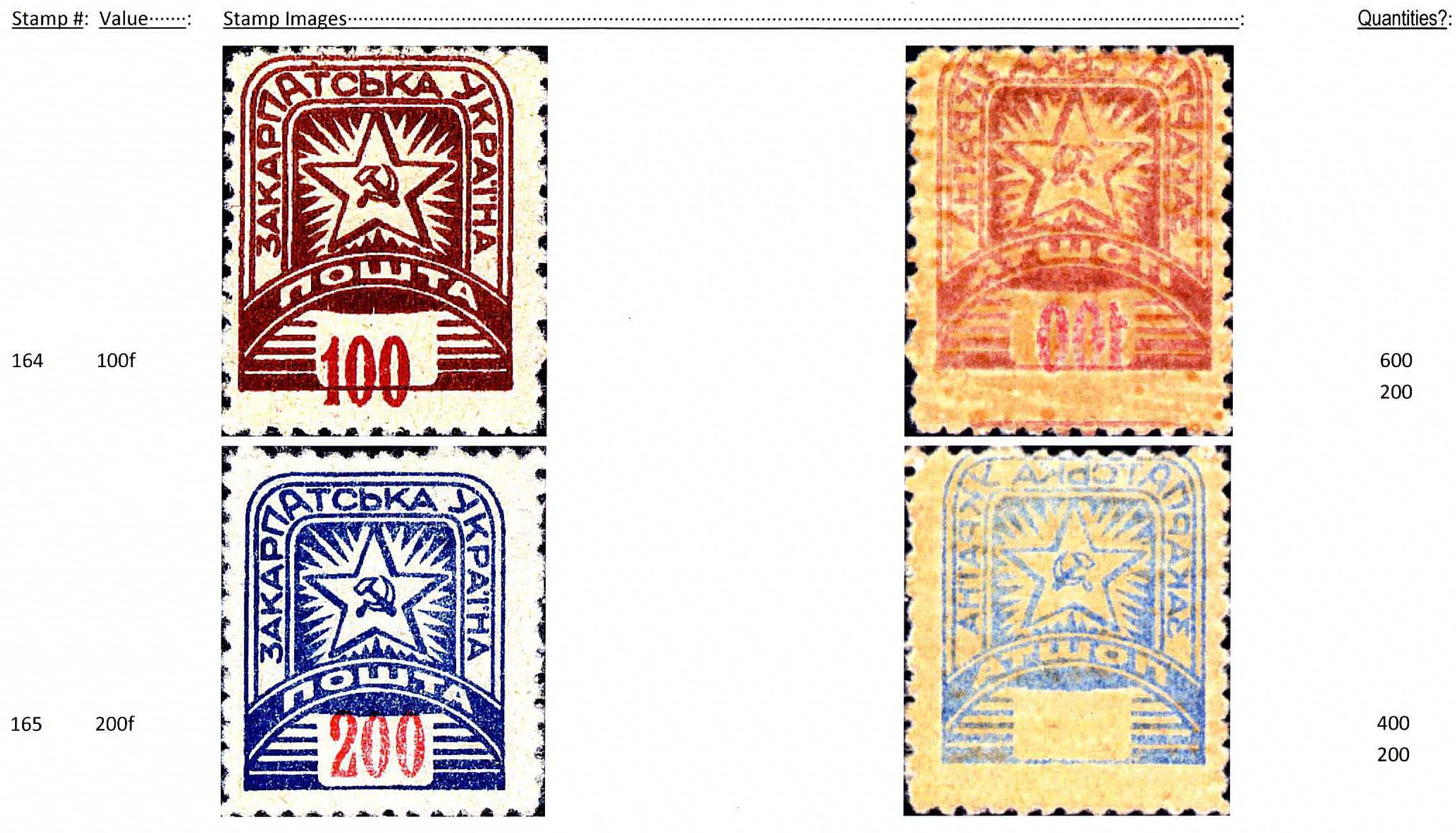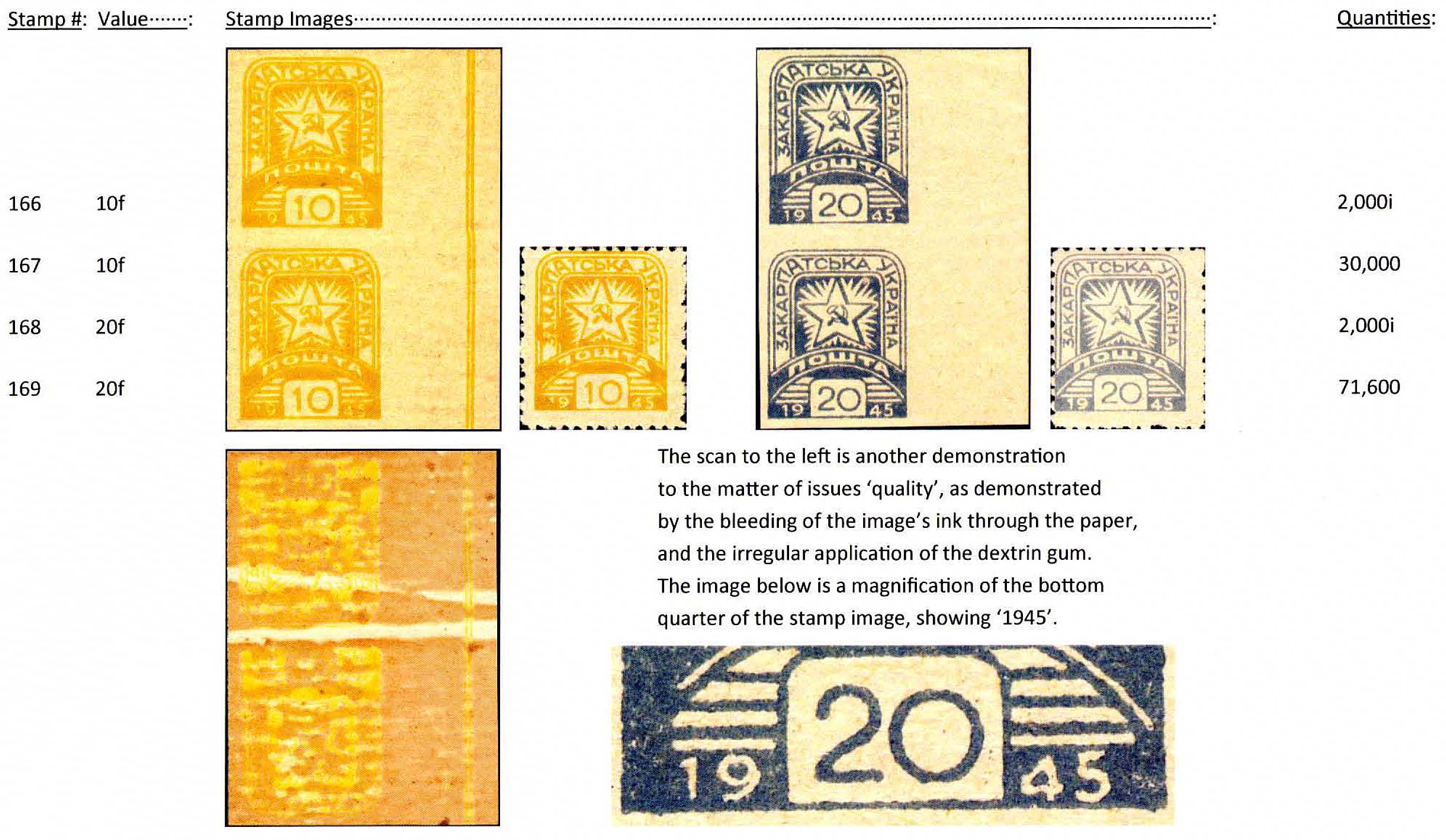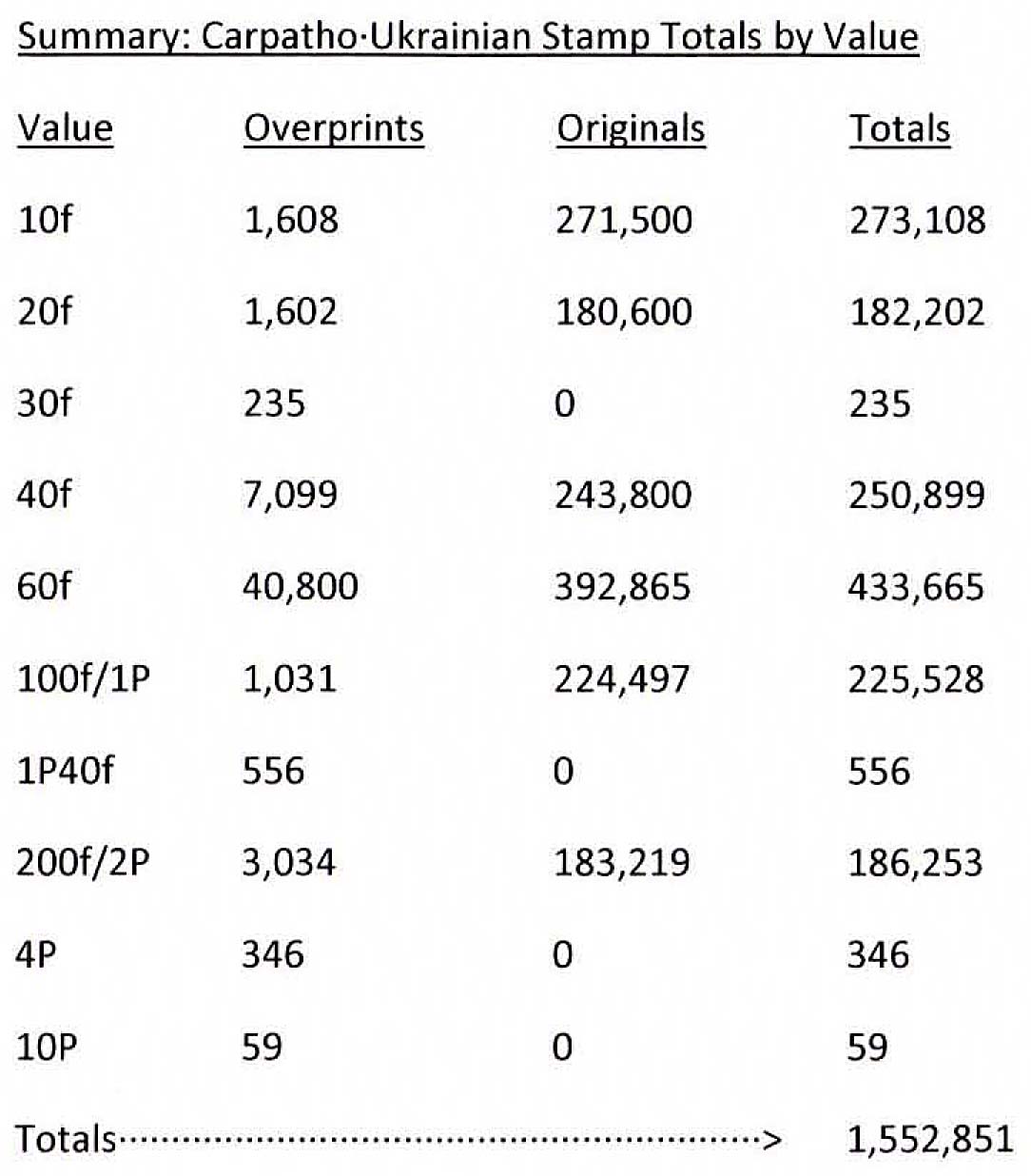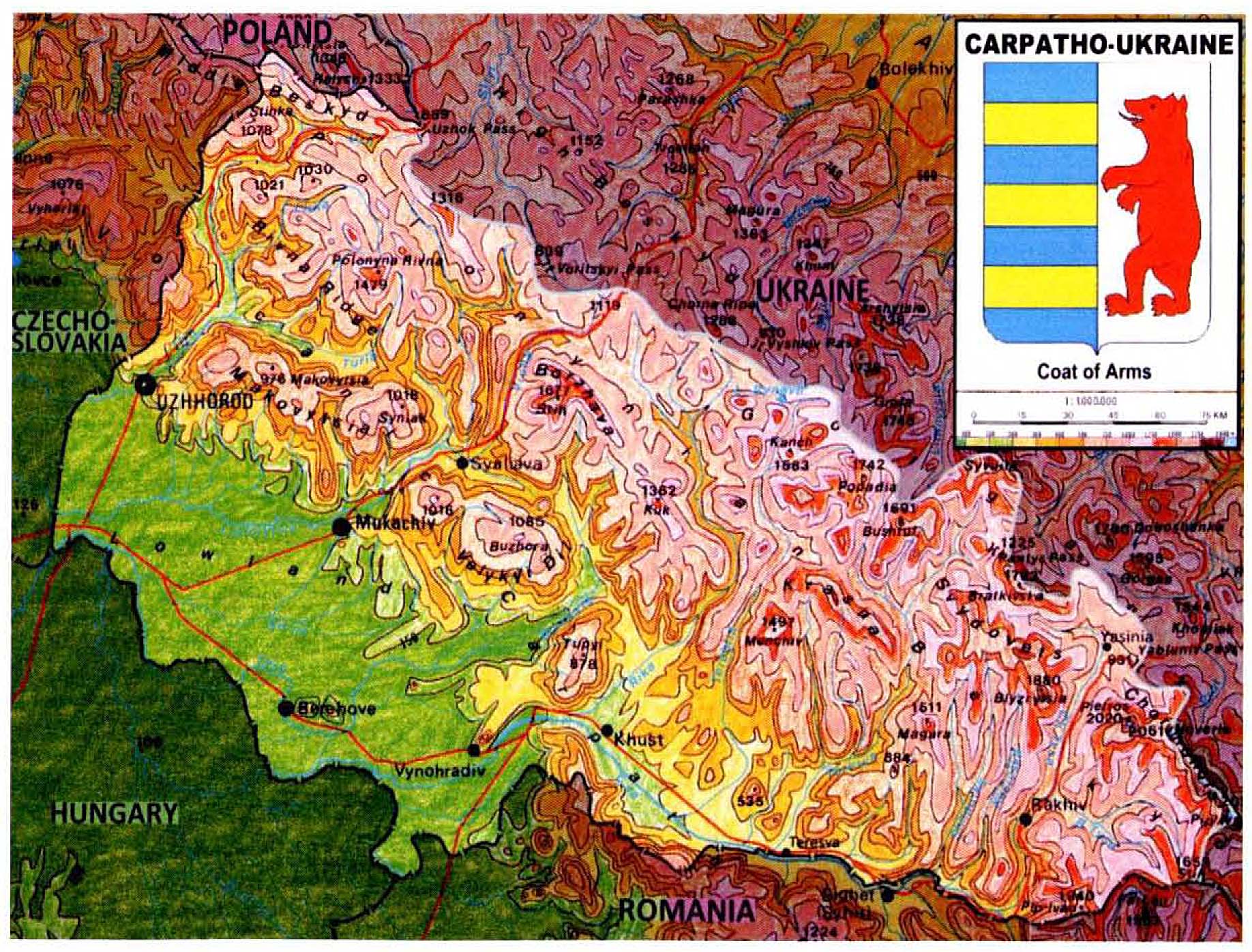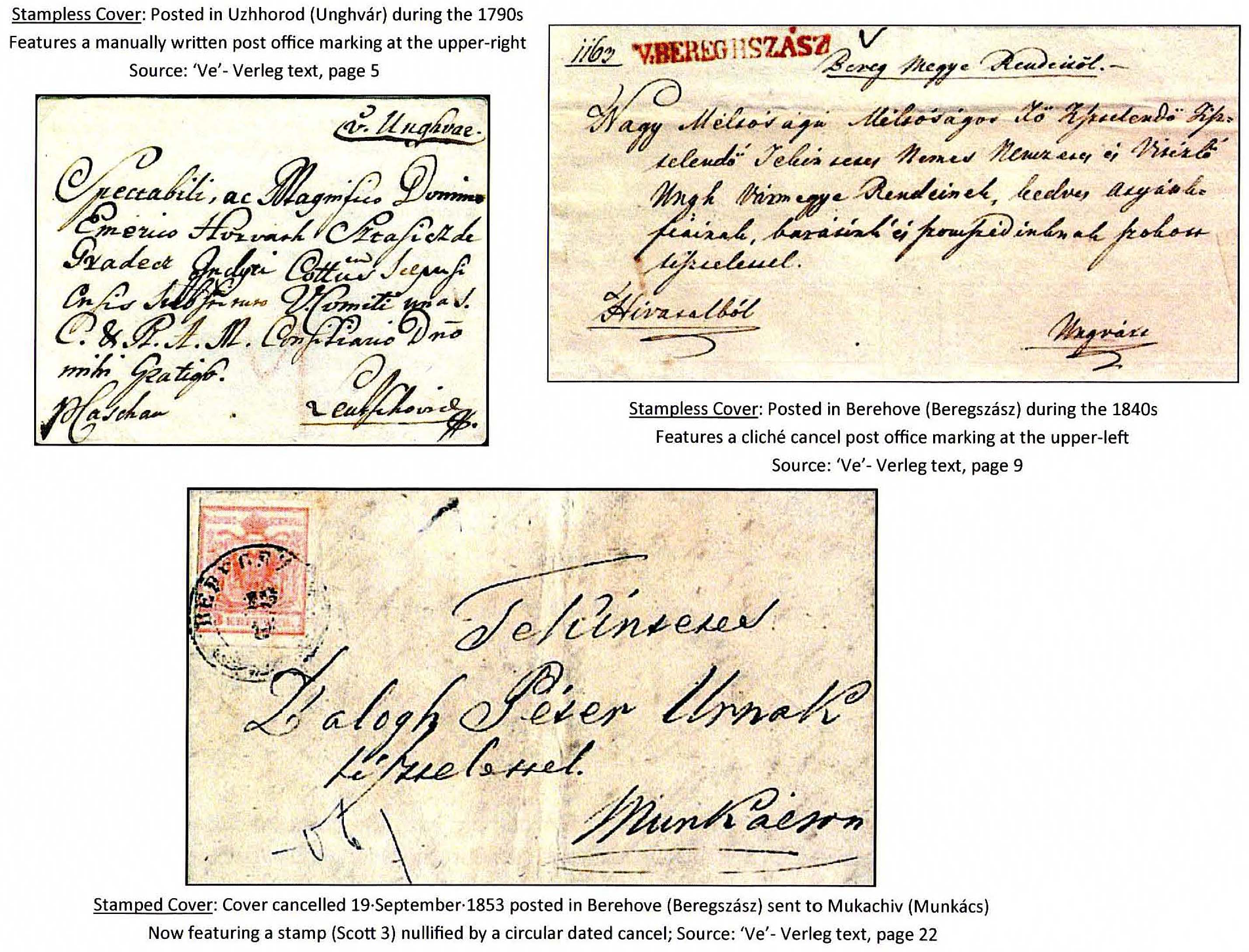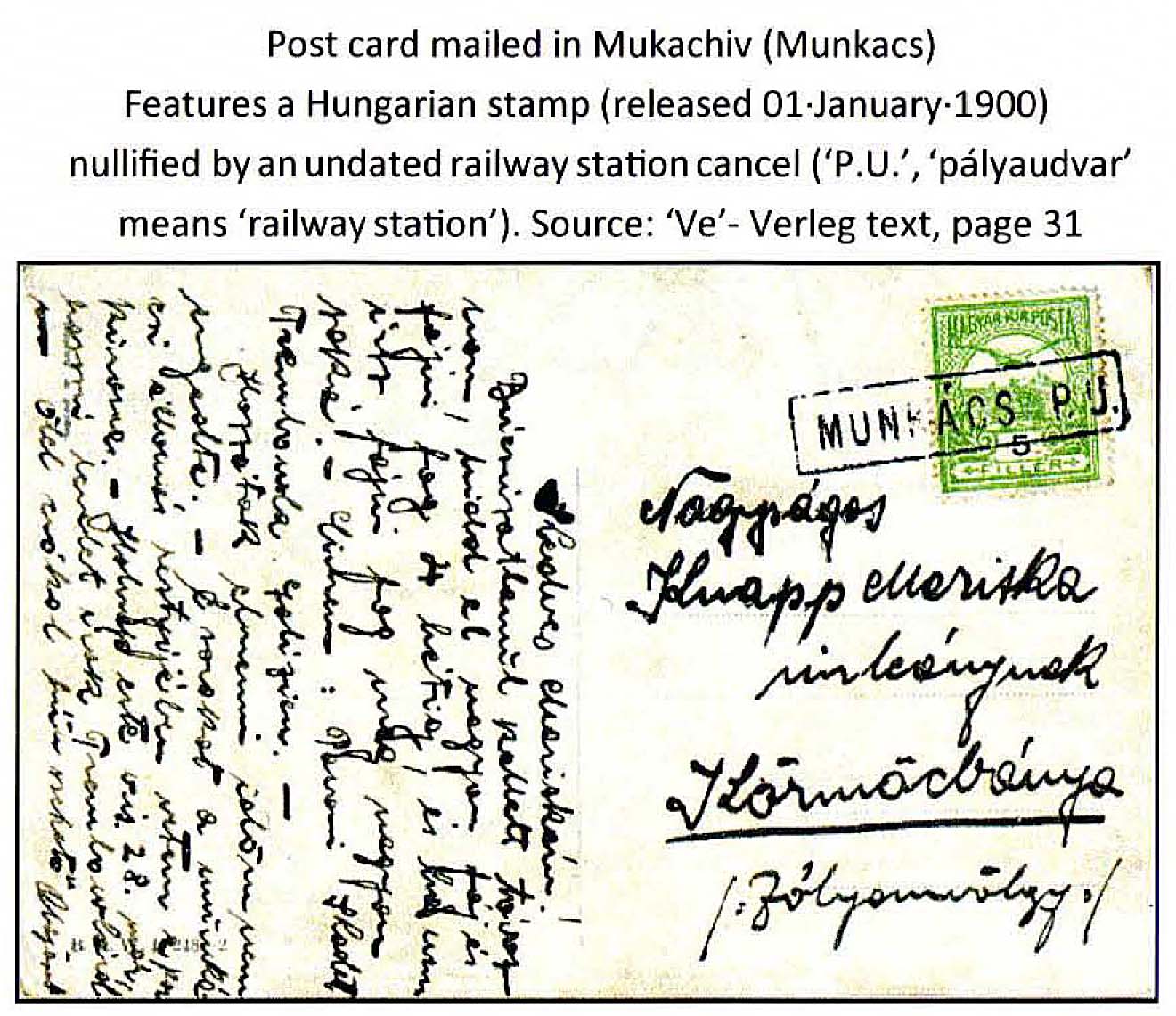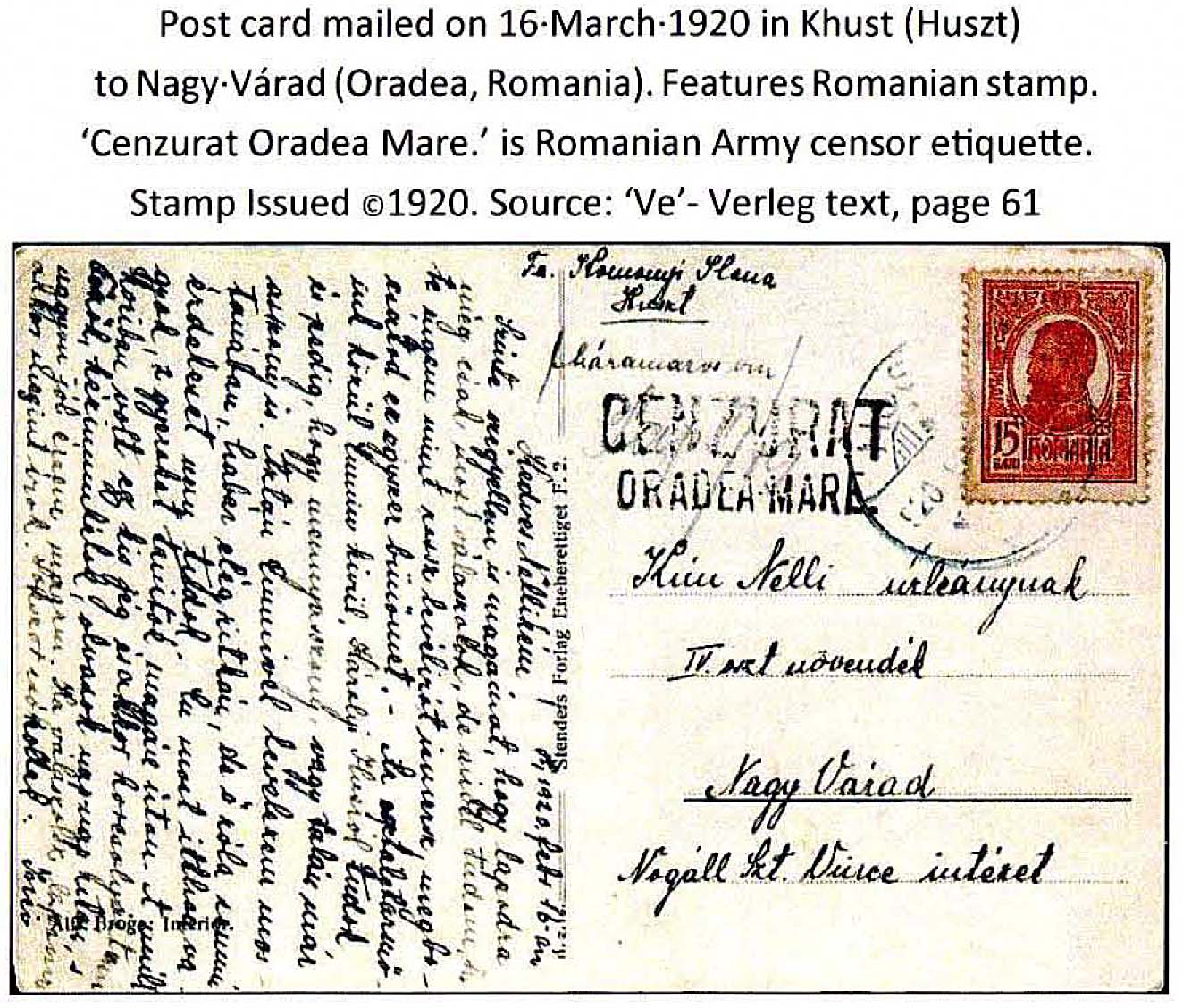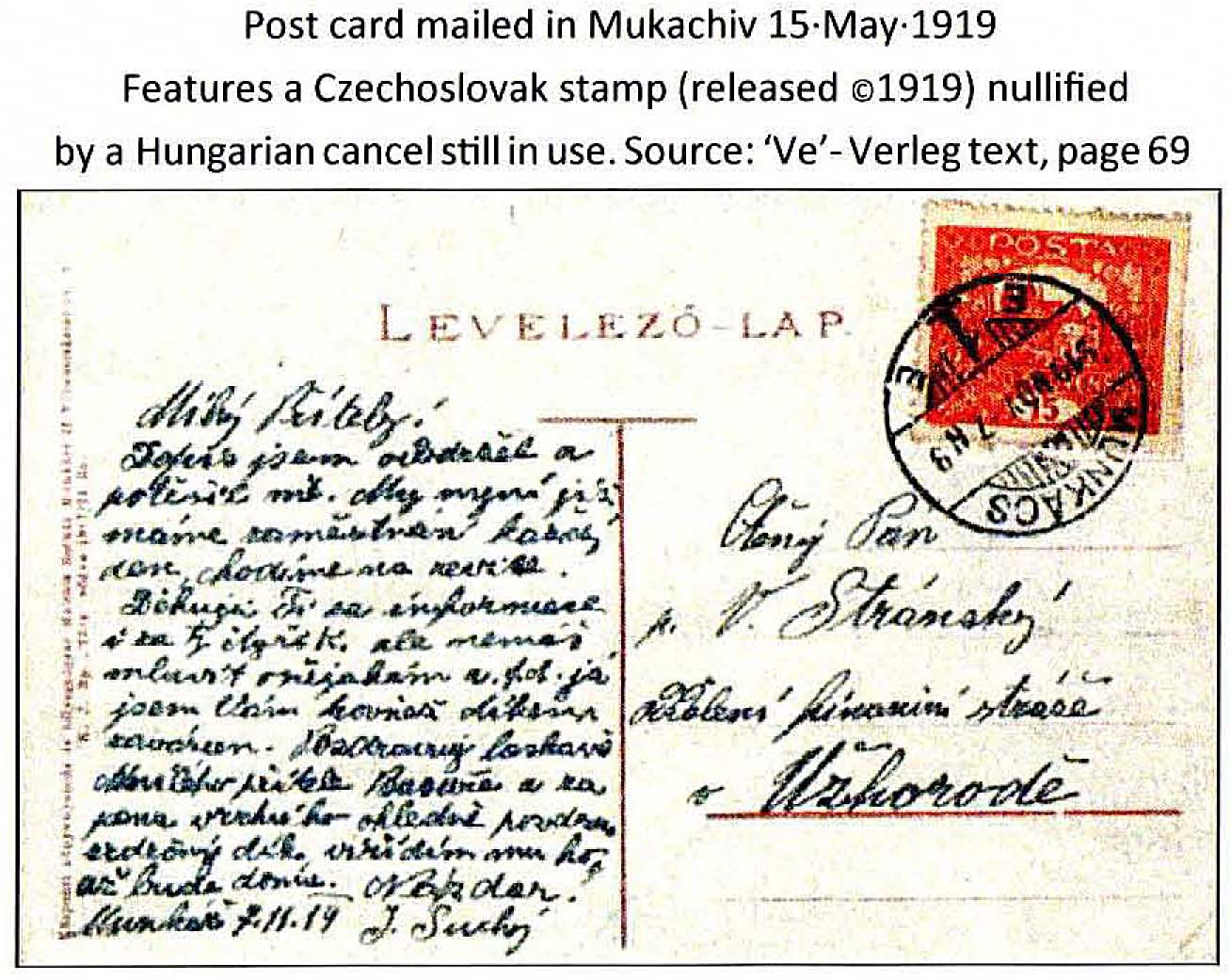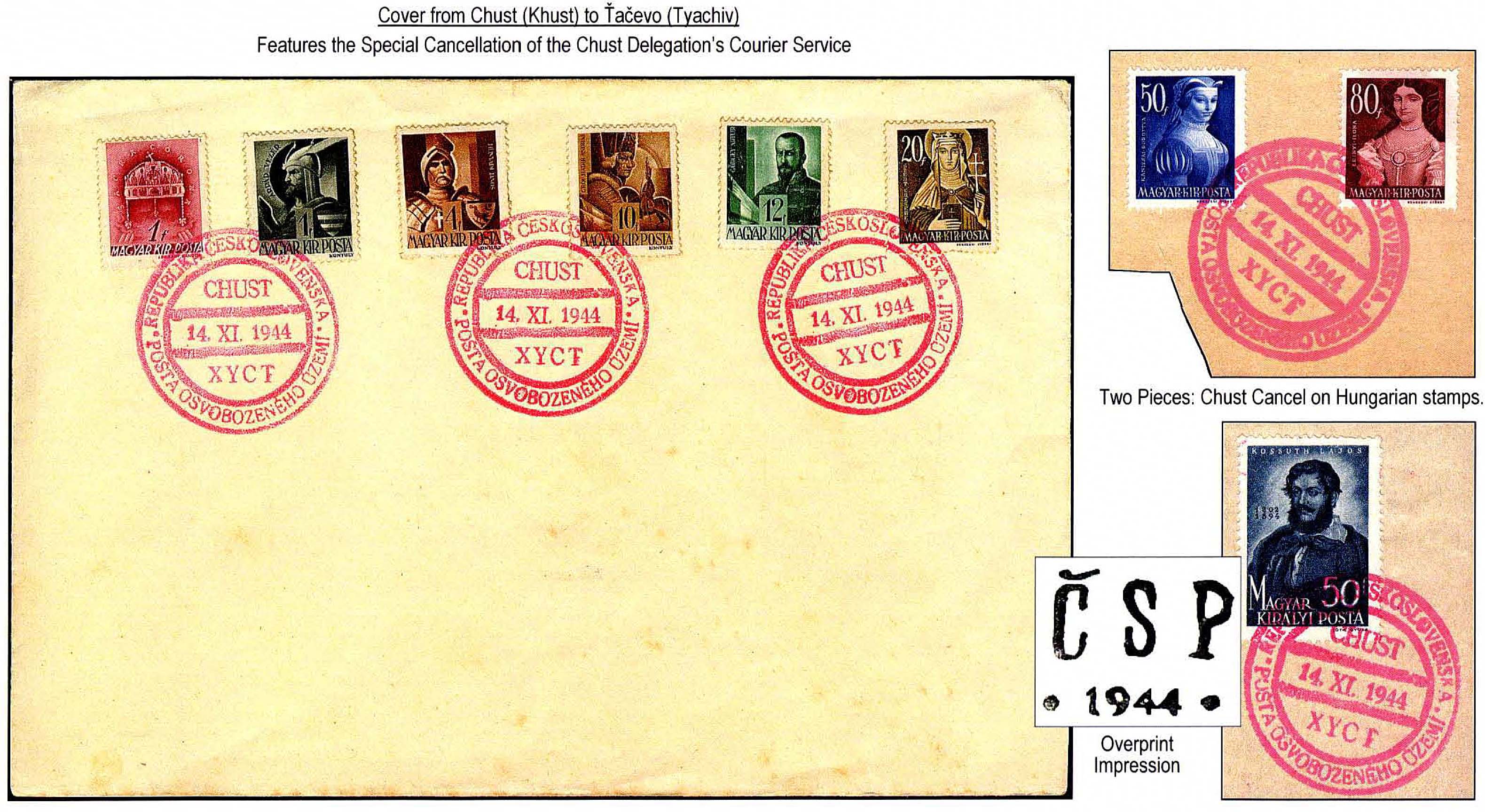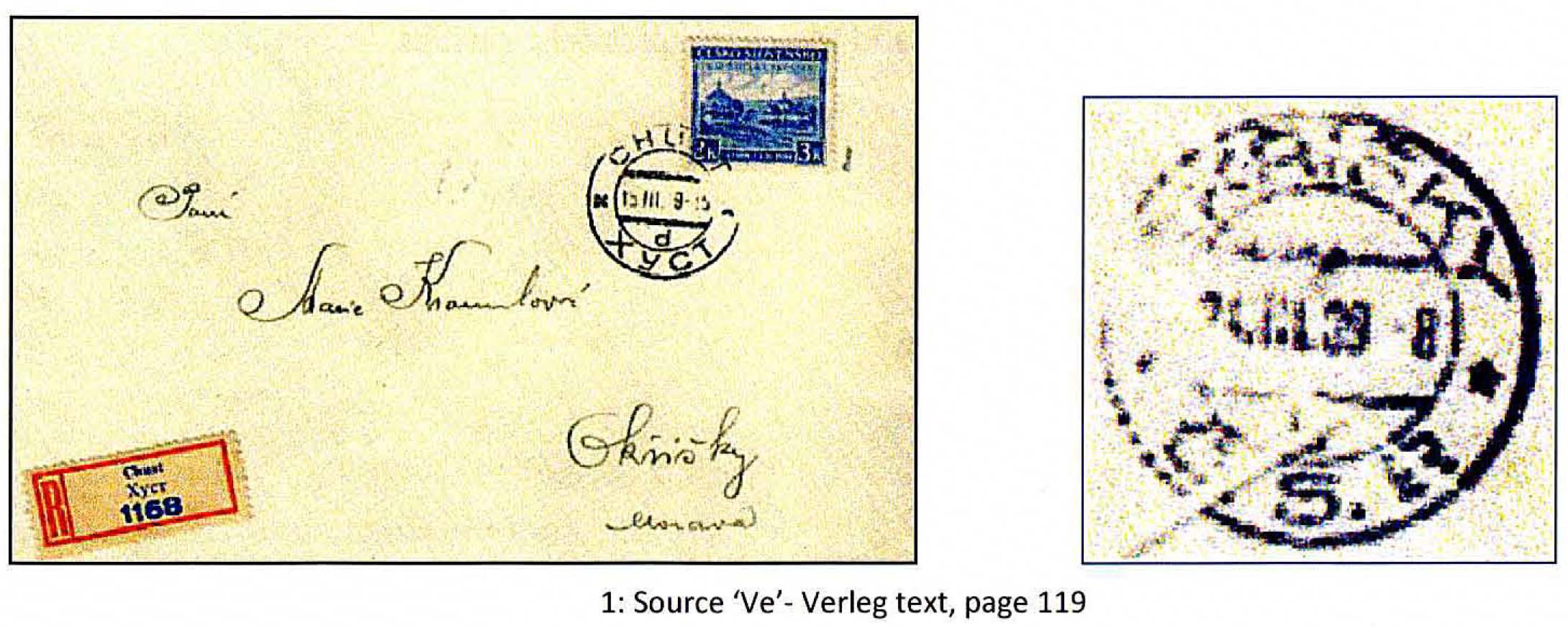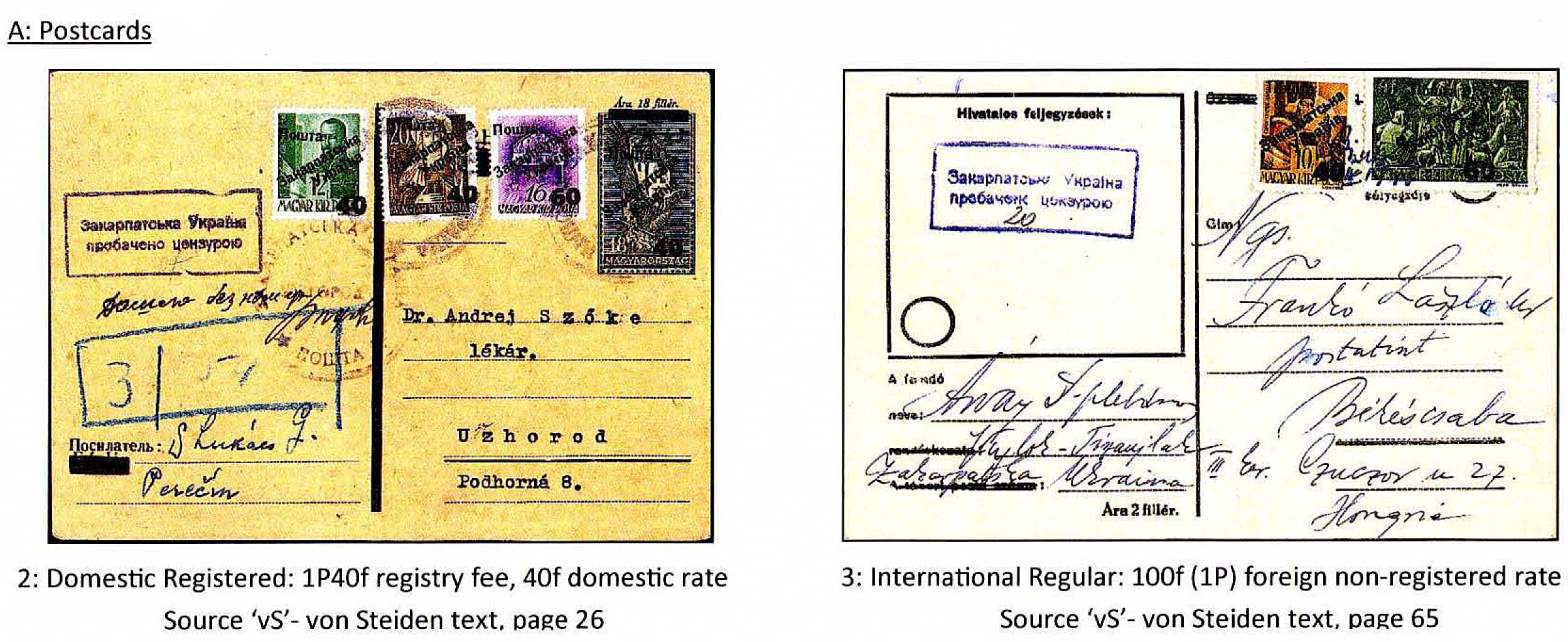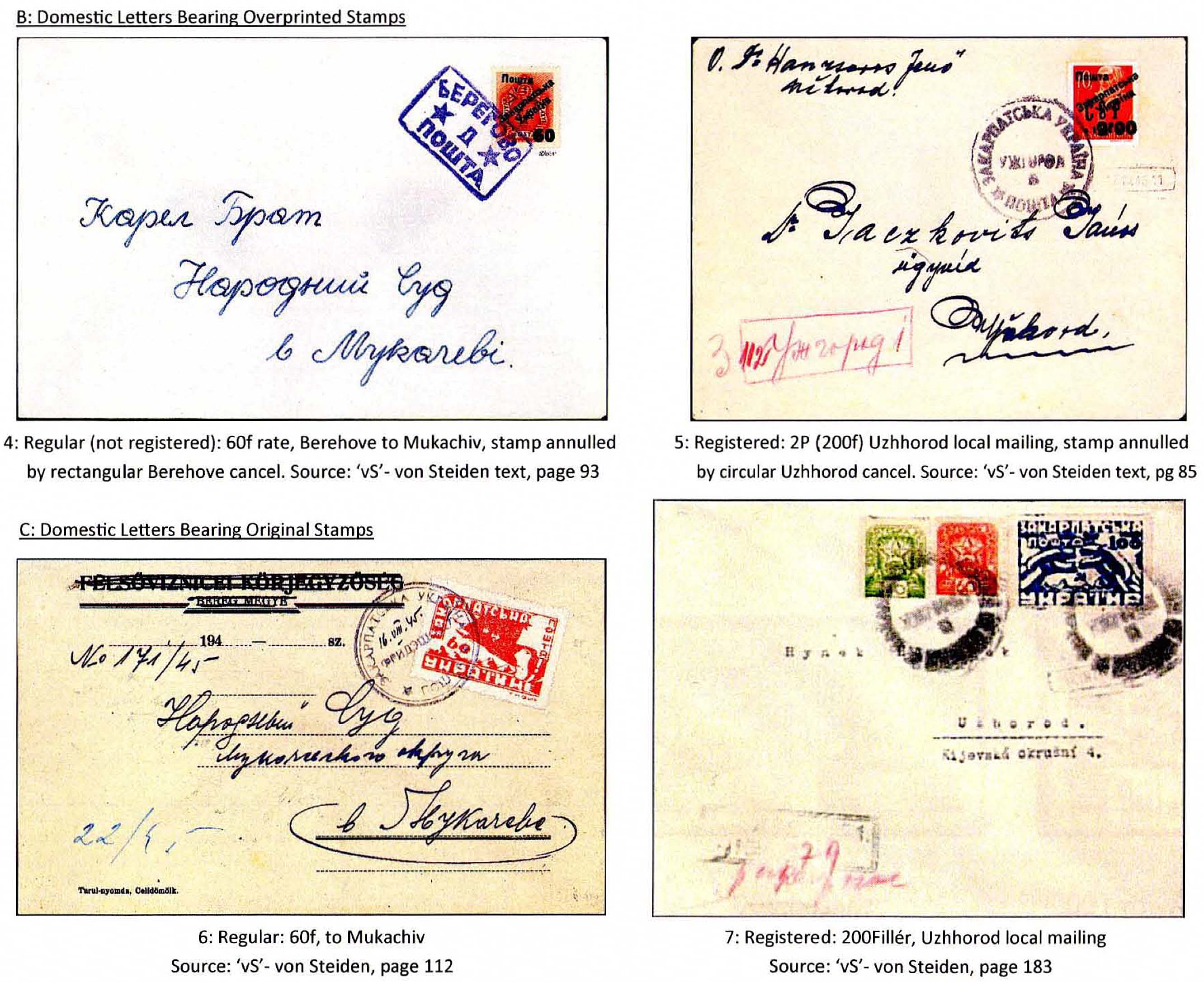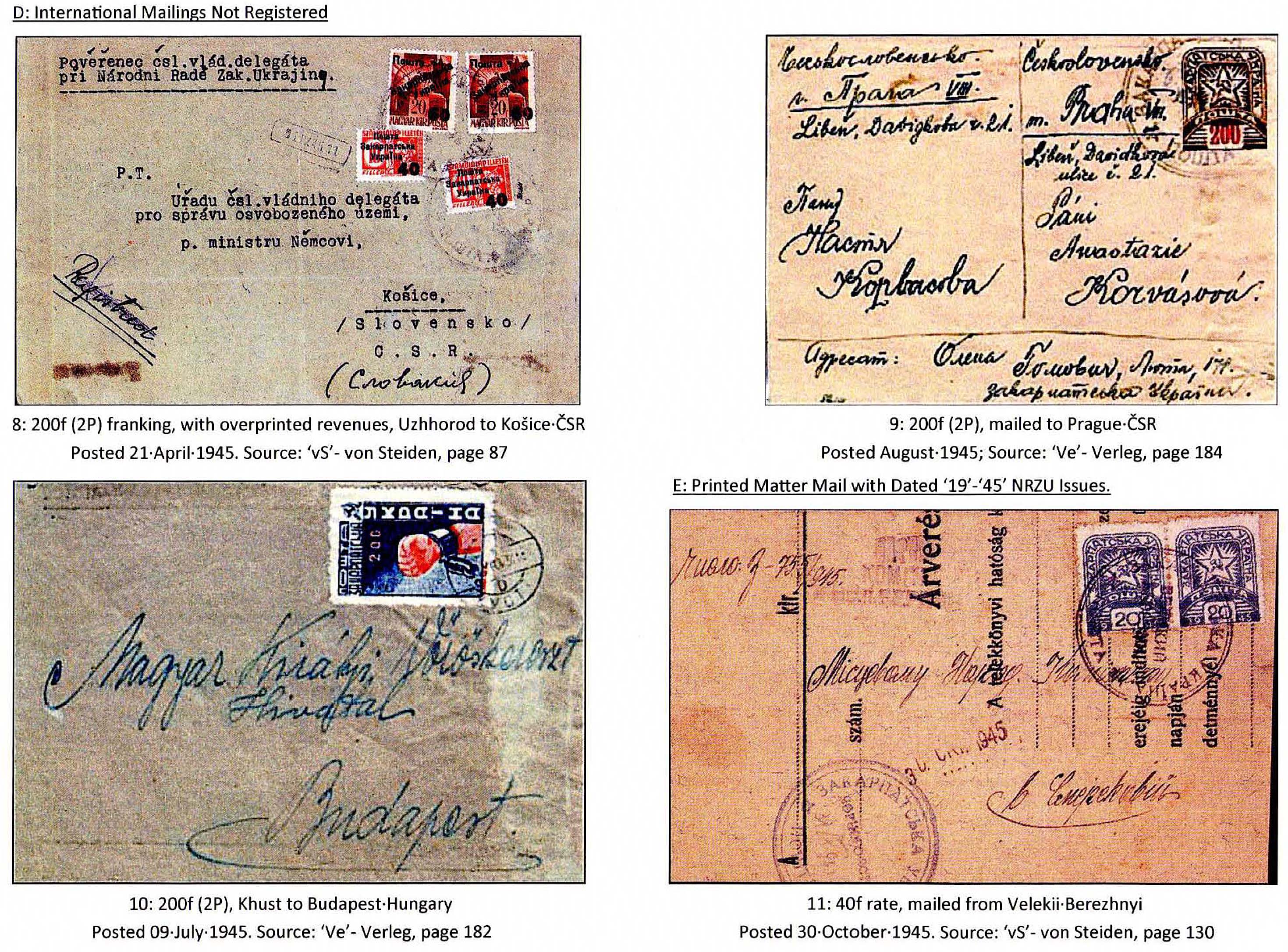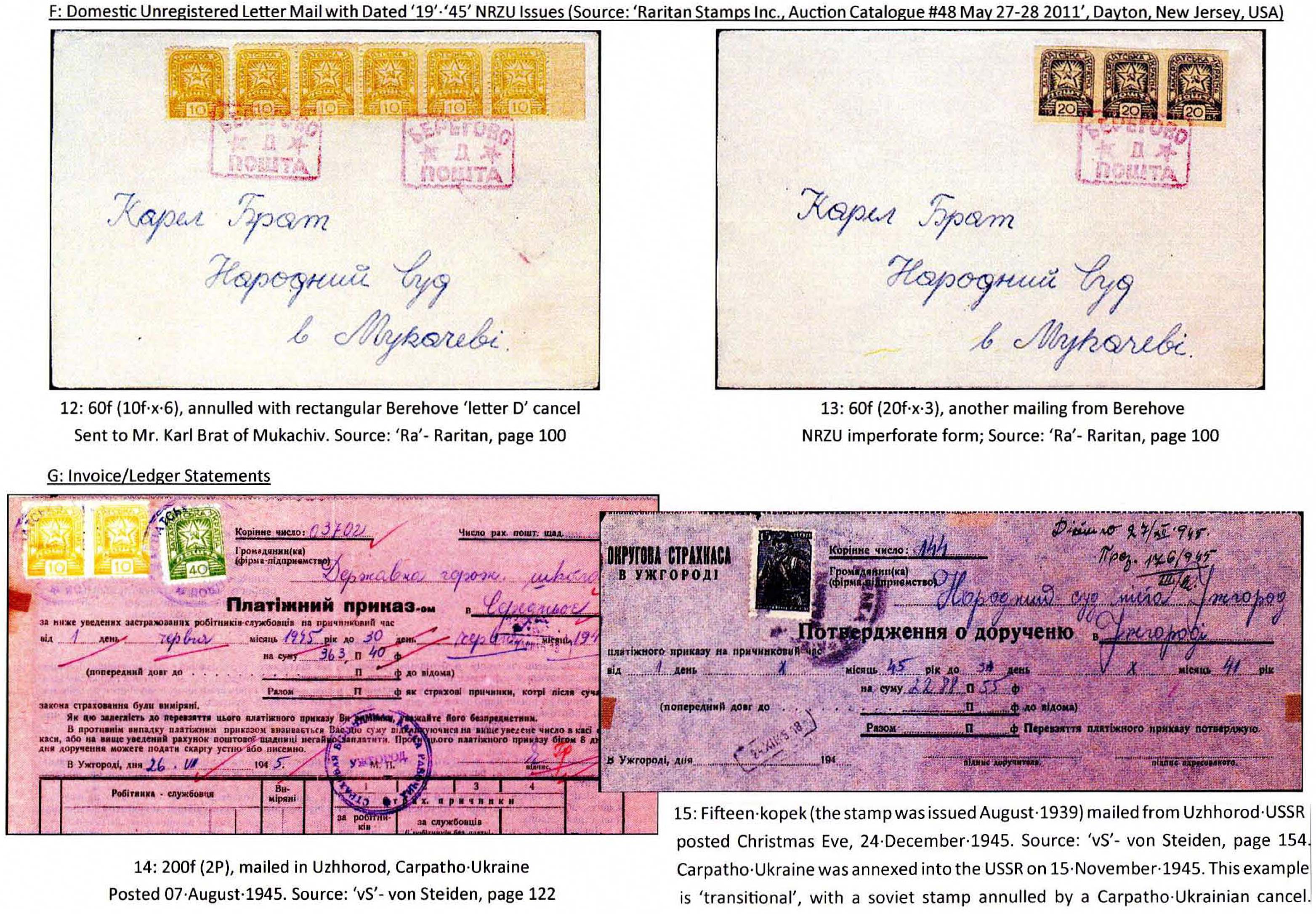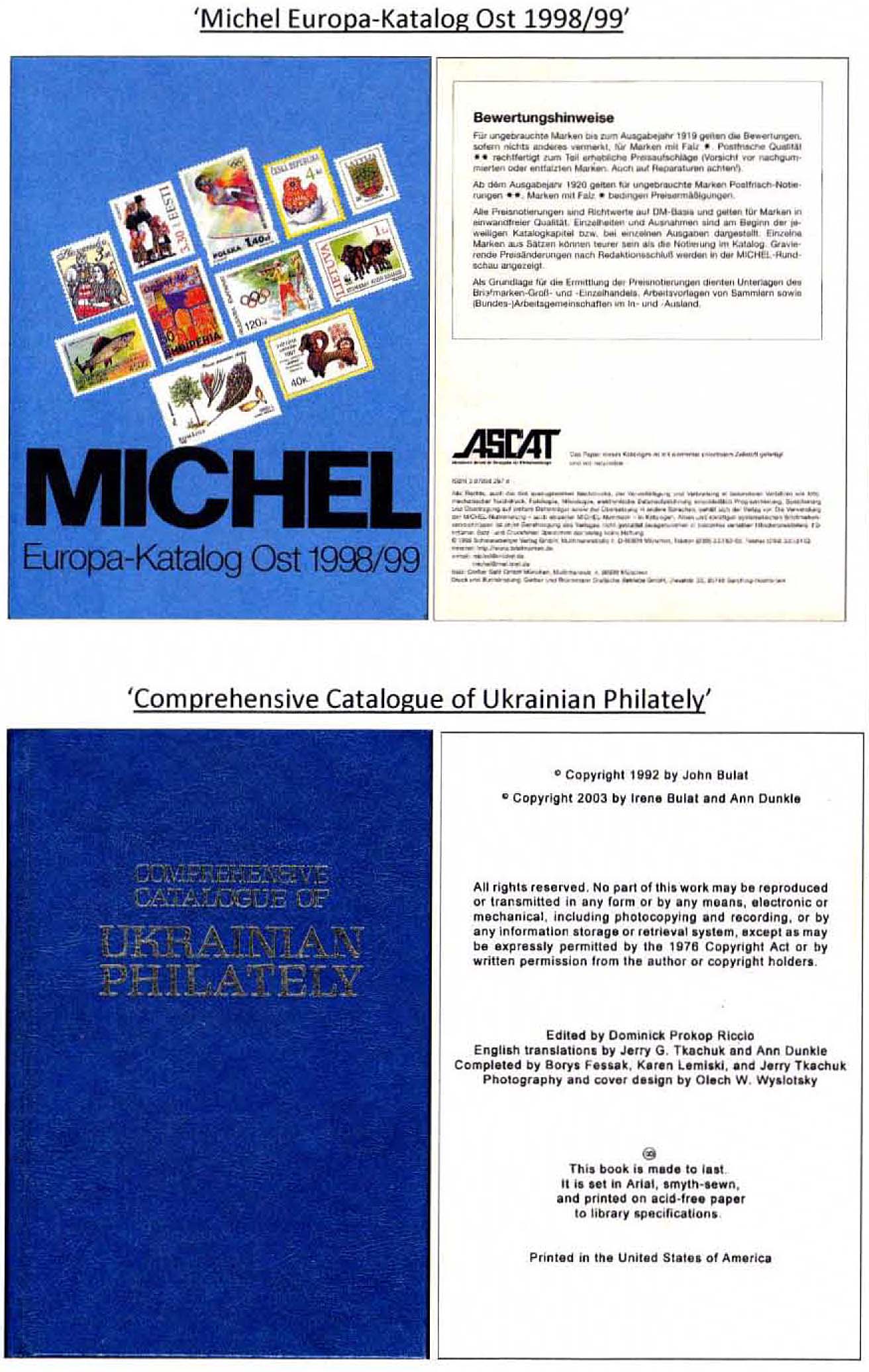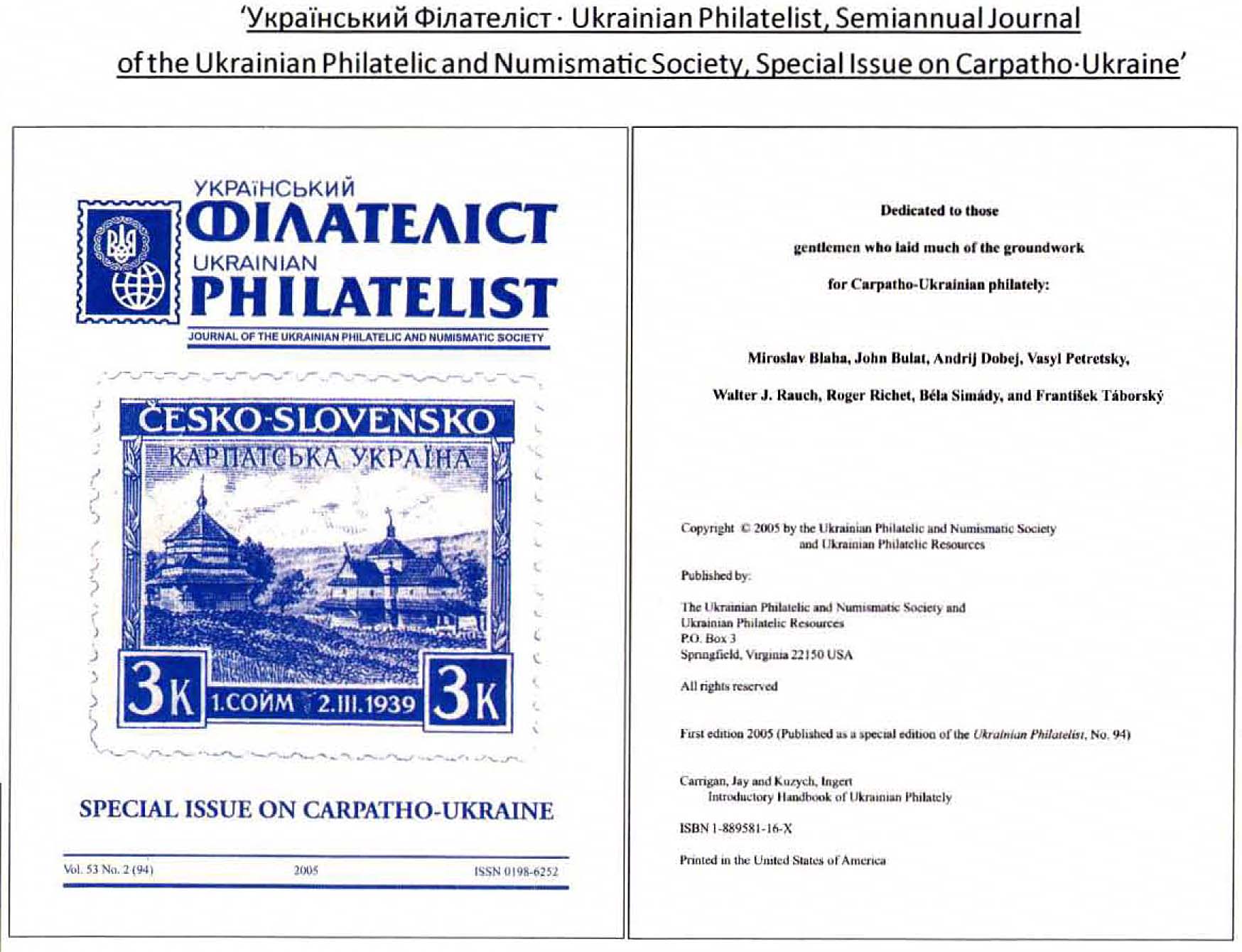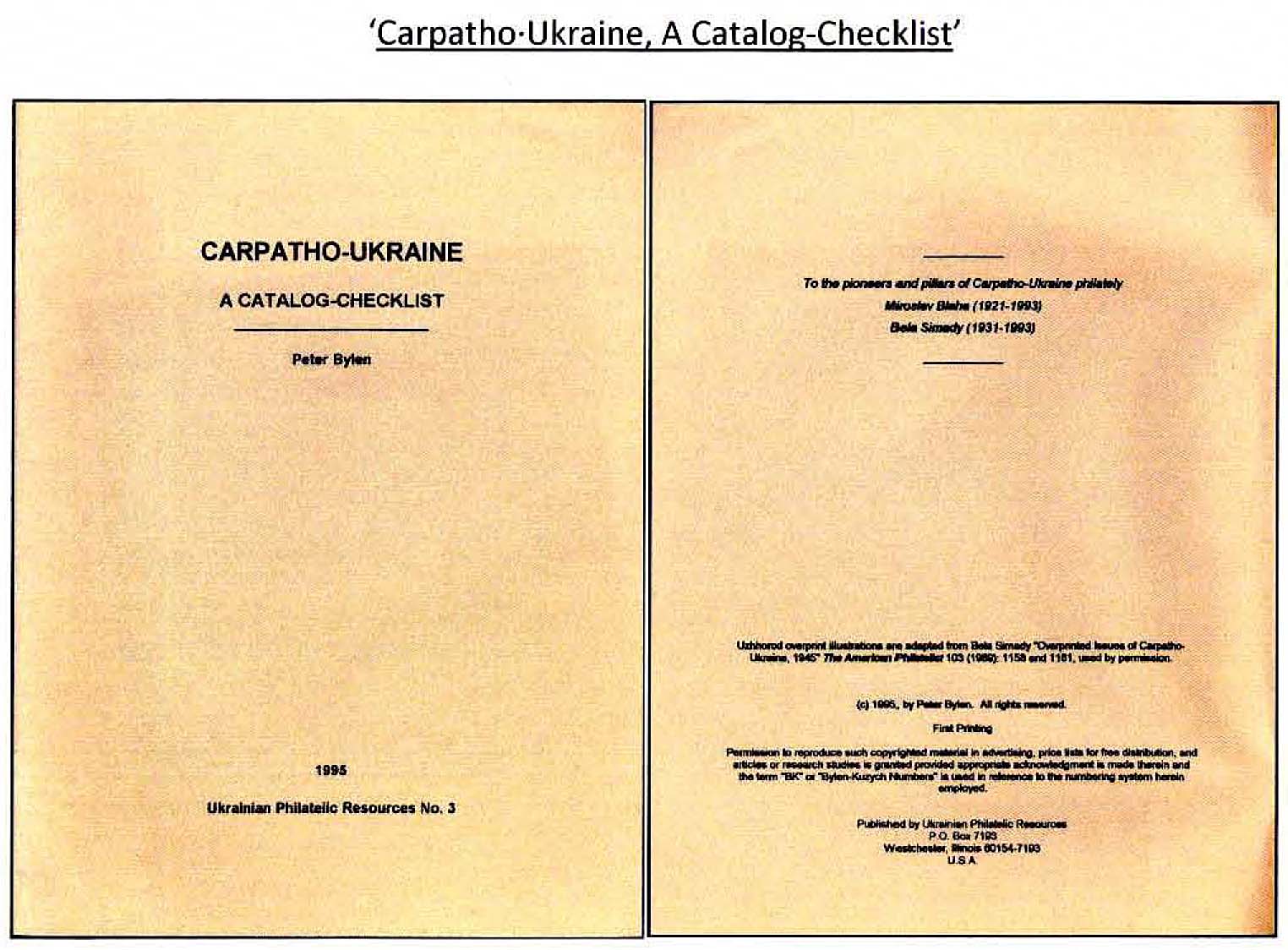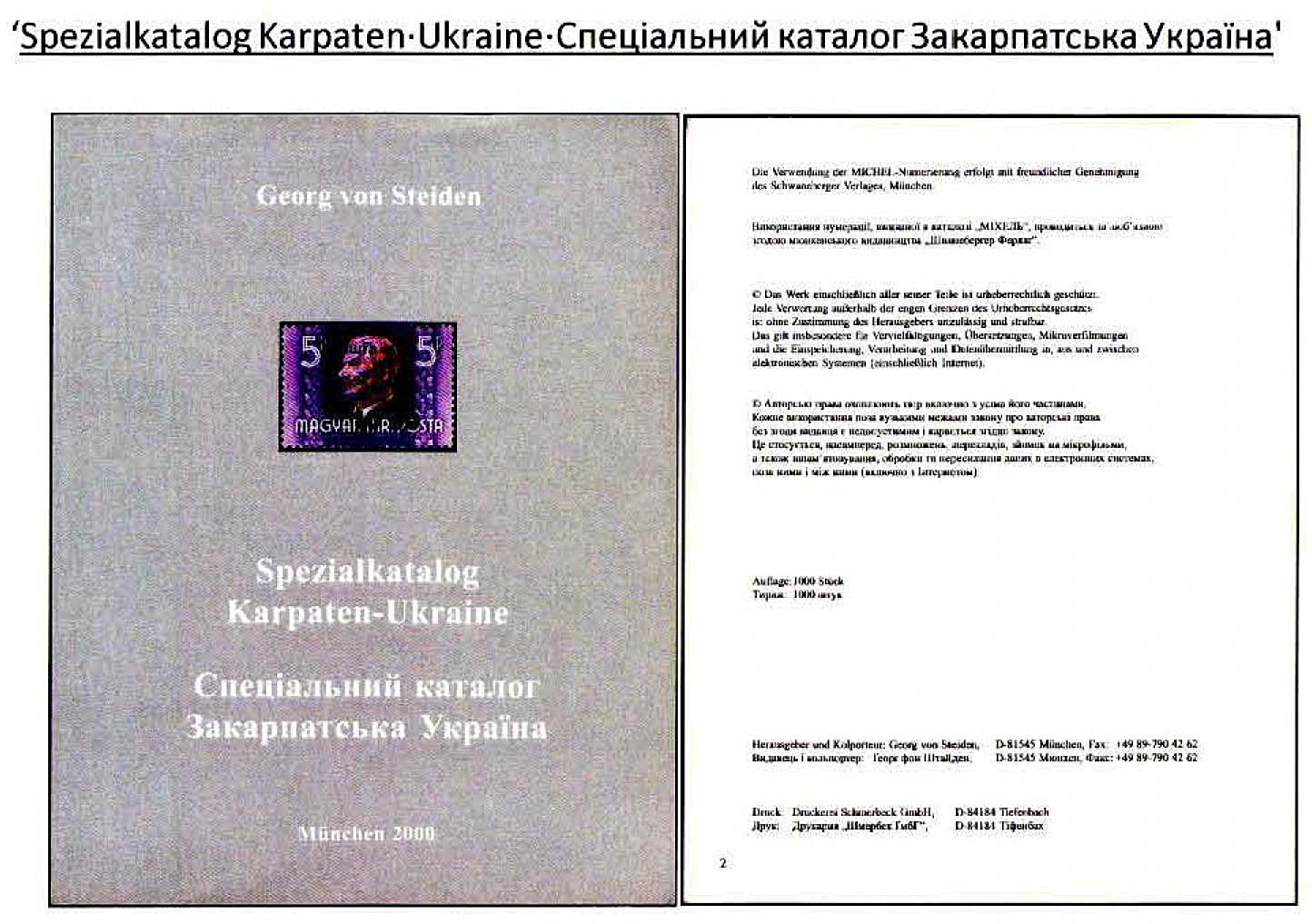 This study was initiated during 2013, and was circulated to society peers for vetting and feedback in October 2015. It elaborates on a genre of philately which is not as well-known as it should be. When Carpatho-Ukraine existed as a country, so very briefly in 1939 before being occupied by a neighbouring power, and then for most of 1945 before being absorbed into a neighbouring super-military, it produced stamps for 'its public'. These were a people who wanted their identity to be reflected in nationhood, though who had little choice but to bow to the dominance of others. Thus, and despite their locally produced stamps, some would argue that the nation of Carpatho-Ukraine was no more than a puppet of others, and so, not yet recognized by some philatelists who at the same time honour others with a similar history. It is a hope that this compilation will shed more light on the stamps that this small entity produced, and, as well, some of the history that these issues reflect. Know that there are many other Carpatho-Ukraine stamp texts, which this author learned from, that were completed by excellent members and friends of our UPNS!
This study was initiated during 2013, and was circulated to society peers for vetting and feedback in October 2015. It elaborates on a genre of philately which is not as well-known as it should be. When Carpatho-Ukraine existed as a country, so very briefly in 1939 before being occupied by a neighbouring power, and then for most of 1945 before being absorbed into a neighbouring super-military, it produced stamps for 'its public'. These were a people who wanted their identity to be reflected in nationhood, though who had little choice but to bow to the dominance of others. Thus, and despite their locally produced stamps, some would argue that the nation of Carpatho-Ukraine was no more than a puppet of others, and so, not yet recognized by some philatelists who at the same time honour others with a similar history. It is a hope that this compilation will shed more light on the stamps that this small entity produced, and, as well, some of the history that these issues reflect. Know that there are many other Carpatho-Ukraine stamp texts, which this author learned from, that were completed by excellent members and friends of our UPNS!
This study was initiated during 2013, and was circulated to society peers for vetting and feedback in October 2015. It elaborates on a genre of philately which is not as well-known as it should be. When Carpatho-Ukraine existed as a country, so very briefly in 1939 before being occupied by a neighbouring power, and then for most of 1945 before being absorbed into a neighbouring super-military, it produced stamps for 'its public'. These were a people who wanted their identity to be reflected in nationhood, though who had little choice but to bow to the dominance of others. Thus, and despite their locally produced stamps, some would argue that the nation of Carpatho-Ukraine was no more than a puppet of others, and so, not yet recognized by some philatelists who at the same time honour others with a similar history. It is a hope that this compilation will shed more light on the stamps that this small entity produced, and, as well, some of the history that these issues reflect. Know that there are many other Carpatho-Ukraine stamp texts, which this author learned from, that were completed by excellent members and friends of our UPNS!
INTRODUCTION: CARPATHO· UKRAINE STAMPS
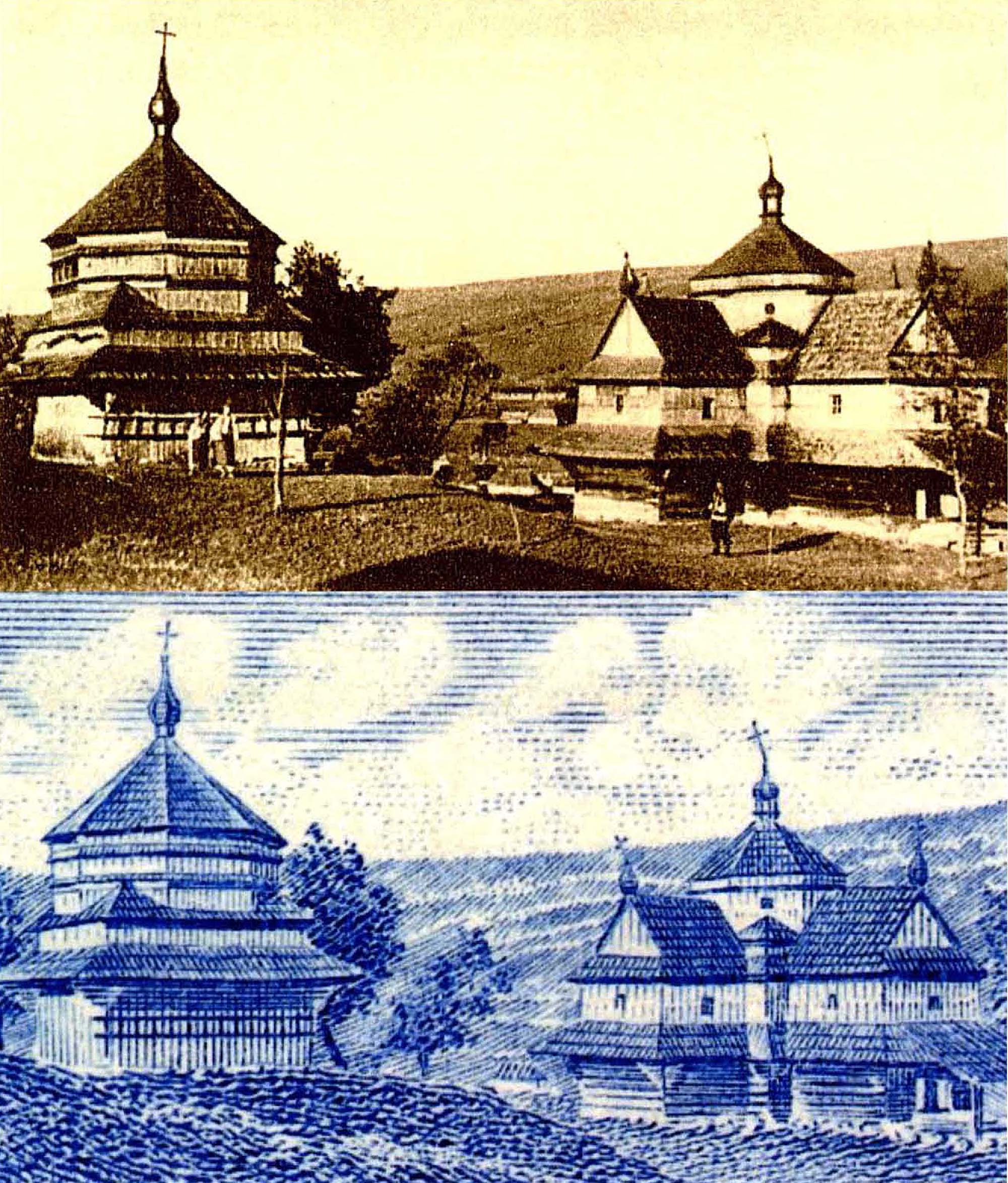 What can be said about a nation of Europe that was by will or by want? This beautiful mountain region, with its subalpine valleys, plateaus, and river systems, is rich in clean air, water, and scenery. It has seen a very diverse history, one that has most certainly enriched its multi-cultural nature. Its beauty nurtures the soul, and its innocence enriches the spirit!
What can be said about a nation of Europe that was by will or by want? This beautiful mountain region, with its subalpine valleys, plateaus, and river systems, is rich in clean air, water, and scenery. It has seen a very diverse history, one that has most certainly enriched its multi-cultural nature. Its beauty nurtures the soul, and its innocence enriches the spirit!
'The ancient name for Carpatho-Ukraine was 'Pidkarpatska-Rus’’. During the 10th and 11th century, it was part of Kyivan-Rus’.Toward the end of the 11th century, it was annexed to the Hungarian crown. In 1870, the territory was taken over by Austria-Hungary, and after the 1918 disintegration of the empire, a small part was occupied by Rumania.
On 21 January 1919, Pidkarpatska-Rus' declared its unification with the Ukrainian National Republic. However due to the territorial apportionment, it become a part of the 'Czecho-Slovak Republic' as an autonomous territory based upon the Treaty of St. Germaine on 10 November1919. The Prague government, instead of autonomy, ... instituted their own rule. On 7 October 1938, Pidkarpatska-Rus' proclaimed a'Ukrainian Autonomous Government', and on October 11, it became a part of the 'Ukraino Czecho-Slovak Federated Republic'.
The 'Munich Conference' on September 29-30, 1938, and the 'Vienna Arbitration' on November 2,1938 sped up the events in the Czecho-Slovak Republic and particularly in Pidkarpatska-Rus’: The name of Pidkarpatska-Rus' was changed on December 30, 1938 to 'Karpatska Ukraina', Carpatho-Ukraine.
The first postage stamp issued for exclusive use in Carpatho-Ukraine was released on March 15, 1939. ... "1
Four years later, Carpatho-Ukrainian governments would issue another 142 stamps to their public that were locally overprinted, as well as eleven locally created original designs (before varieties such as imperforates).
CARPATHO-UKRAINE'S FIRST NATIONAL ASSEMBLY COMMEMORATIVE ISSUED 15 MARCH 1939
This stamp features a view of the 'Church of the Ascension', also known as 'Struk Church', in the Carpatho-Ukrainian town of Yasinia. While this release commemorated the convocation of the 'First National Assembly of Carpatho-Ukraine’, which was originally scheduled for March 2nd, the occasion was delayed. It was not until March 15th that the event took place. To accommodate this, the stamp's actual release was officially held up until the 15th in order to coincide with the convocation, despite the stamp bearing the original date of March 2nd. Slovakia had declared itself independent at 1pm on Tuesday 14th of March. Carpatho-Ukraine followed suit at 6:30pm that same evening, and its National Assembly went into its first governmental session at 3pm the next day. However the Hungarian army took Khust, Carpatho-Ukraine's seat of government, at 6pm on Thursday. As such, the stamp was on sale within Carpatho-Ukraine for no more than 27 hours! With the invasion, Hungary partitioned Carpatho-Ukraine into 'zones', renaming the largest part 'Kárpátalja'.
This stamp comes with dextrin gum, and its printed design measures 27mm-by-23mm. (It is almost identical to an October 28th, 1928 orange-red 60-haleru release by Czechoslovakia which, ironically, commemorated the 'Tenth Anniversary of Czechoslovak Independence'.) Its face value satisfied the in-era regular-weight domestic letter rate (1 Korona) plus the registry fee (2 Korony). Completed via recess engraving, there are two plate numbers, '1' and '1A'. These numbers are on separate fields, and as such, a combination of the stamp field and an attached plate number field are desirable. There are also blank fields, which are somewhat desirable in their various combinations with the stamp. The paper is not watermarked, but a keen eye will detect broad horizontal 'scoring' via the plate number and blank fields. A total of 900,000 were issued, 300,000 going to Carpatho-Ukraine, specifically the city of Khust, with the rest remaining in Prague Czechoslovakia for sale in its various post offices. Despite this stamp's 3 Korony domestic registered letter rate, some covers are known which went westward from Carpatho-Ukraine to adjacent nations.
THE RE-EMERGENCE OF A CARPATHO-UKRAINIAN GOVERNMENT, OVERPRINTS FEATURES, AND WATERMARKS
With Hungary taking Carpatho-Ukraine, taking control of both the Khust post office at 4:30pm and the seat of government by 6pm on Thursday March 16th, 1939, and partitioning it and renaming it'Kárpátalja' (et al), all postal services were redefined to the Hungarian 'brand', including conversion to Hungary's monetary unit, the 'Pengő'. A few years later, near the end of WW2, the soviet army began to replace the Hungarian army in Carpatho-Ukraine (starting October 15th, 1944), and the soviet brand was soon to replace Hungary's. However there was an 'interim period' of time during this switchover, a period of about nine months from March to November 1945 when a Carpatho-Ukrainian government was formally in charge of its own territory.
On 27 October 1944, a Czechoslovakian-based seat of government was 'restored' in Khust. This government overprinted left-behind Hungarian stamps with 'ČSP 1944', 'Československá Pošta'. However these stamps were never issued, because this restored government soon 'exiled' to Košice,Slovakia during March 1945, taking most of their overprints with them. These overprints were neither properly issued nor used in Carpatho-Ukraine. (Beware of philatelic ČSP covers as 'favour to the influential'.)
Why did the Czechs leave? They were pushed out by what had been a co-existing government seated in Uzhhorod, the 'National Council of Carpatho-Ukraine' (Narodna Rada Zakarpatskoi Ukrainy, 'NRZU'). Czechoslovakia ultimately ceded their Carpatho-Ukrainian 'claim' to the USSR on 29 June 1945. Meanwhile the NRZU government (sympathetic with a soviet regime which, perhaps originally unbeknownst to them, had the true intent to take Carpatho-Ukraine into the USSR), also overprinted Hungarian stamps, making them available to their public on February 10th, 1945. Formal use of these Carpatho-Ukraine issues continued into November 1945 when soviet issues were installed.
These scans show five NRZU overprints. (All of the overprint devices were metal.) The first series, released on February 10, 1945, displays a greater average slope for ‘Закарпатська Україна’ compared to the second series released on March 20th, 1945. While most of these two overprints are black, a few are red. The third example, only in black, is the result of left-behind (ČSP overprints being again overprinted for the March 20th, 1945 release. The fourth and fifth overprints (at the bottom), only black, were used on small revenues overprinted for use as 'regular' stamps, the first of these used during the February release and the other during the March release. Finally, to the scans of watermark's 'A' and 'B'2 many of the stamps are watermarked2, which becomes an important variable in the case of some issues.
TARIFF RATES, NRZU 'ПОШТА ЗАКАРПАТСЬКА УКРАЇНА' OVERPRINTS, AND THIS COMPILATION'S ORGANIZATIONAL METHODOLOGY
Denomination: The overprints on the Hungarian stamps did not indicate any kind of denomination, whether returning to the Czech standard or staying with the Pengő. The current consensus, then, is that during Carpatho-Ukraine's period of independence, the denomination remained the Pengő (100 fillér'f' = 1 Pengő 'P'), a conclusion which seems to be supported by the initial tariff rates, and explained as follows.
Tariff Rates ' 1': The last set of Hungarian tariff rates in Kárpátalja were established in July 1943. Of these, the 'regular weight' rates (up-to-20g) were as follows: postcards- local 12f, domestic 18f; letters- local 20f, domestic 30f; further charges- registration or express, local 50f, domestic 70f; return or inquiry receipt (verifying the successful completion of the mailing), 200f. These rates continued after the Hungarian retreat from Carpatho-Ukraine during October 1944.
Tariff Rates '2': New rates, established starting March 1st, 1945, took place during the third week of the first edition overprints, as follows: 40f- printed matter; 40f- domestic postcard; 1P- foreign postcard; 60f- domestic letter; 2P- foreign letter; 1P40f- registration.
'Independence': Hungarian rule of Carpatho-Ukraine was formally replaced by the Czechs on October 27th, 1944, who in turn were soon replaced by the NRZU, informally on or about November 26th, 1944, then formally on or about January 3rd, 1945. The soviet-leaning NRZU governed from their seat in Uzhhorod, for about eleven months, until Carpatho-Ukraine was formally annexed into the USSR on 15 November 1945. Its tariff rates and stamps lost their validity the previous day, replaced by the USSR's, though letters with Carpatho-Ukrainian stamps were processed by the soviets as late as December 13th, 1945, indicating an informal transition period. Further, Carpatho-Ukraine's rubber annulling cancels were used into February 1946.
Interim Period: On January 3rd, 1943, post offices started to return their Hungarian stamps to Uzhhorod's central post office in preparation for overprinting. Those already in circulation were honoured until the release of the overprints.
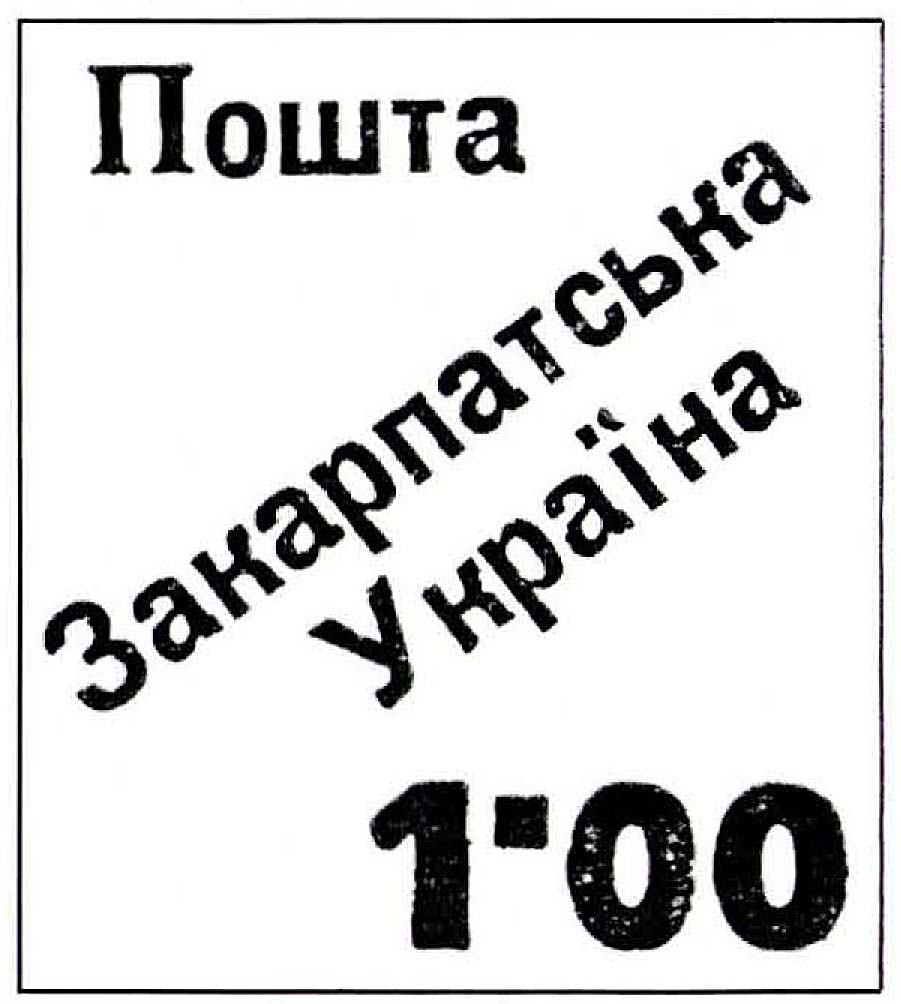 First Edition Overprints: The first-edition era began on February 10th, 1945 with the release of twenty-seven overprinted issues, completed with a device equal to vertical strips-of-ten. While the slope of 'Закарпатська Україна' in the 'large format' overprint (to the left) is 36½°, which meets the standard, confirmed first edition variances range from 34° to 38°.
First Edition Overprints: The first-edition era began on February 10th, 1945 with the release of twenty-seven overprinted issues, completed with a device equal to vertical strips-of-ten. While the slope of 'Закарпатська Україна' in the 'large format' overprint (to the left) is 36½°, which meets the standard, confirmed first edition variances range from 34° to 38°.
Overprint Measurements: Large format average text lengths: 'Пошта' 10mm; 'Закарпатська' 21mm; 'Україна' 12½mm; height small-case letters without appendages l¾mm, with appendages 2½mm, capital letters 2½mm, zero 3-by-4mm; 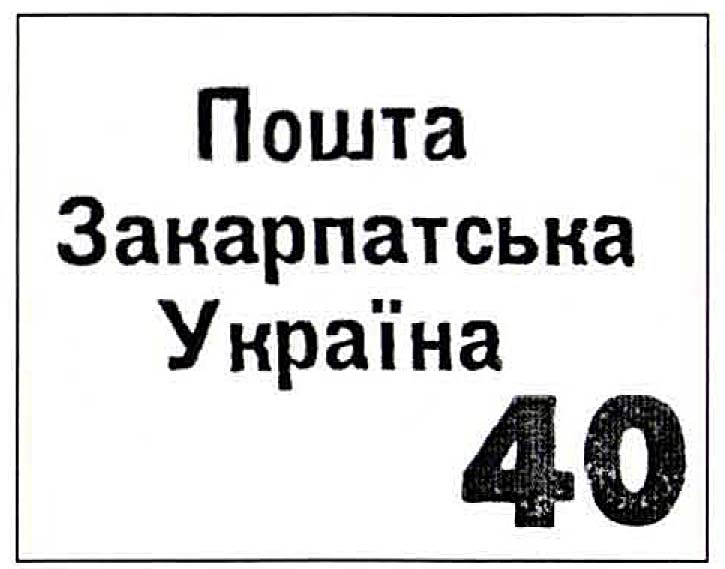
Small format overprint (to the right)- average text lengths: 'Пошта' 8mm; 'Закарпатська' 16mm; 'Україна' 9½mm; height small-case letters without appendages l½mm, with appendages 2mm; capital letters 2mm; zero 2-by-3mm.
Numbering System: Overprints are arranged in revalue order per Carpatho-Ukraine edition, since the overprinted stamps have now been reconfigured to meet Carpatho-Ukrainian standards.
Varieties: This listing accounts for inverts ('i') and watermarks. Consult specialist catalogues for the other varieties, such as the following: serif style 'n' in the word 'Пошта' (to the left), where the printing company sometimes ran out of non-serif styles, as also happened with the capital '3' . There are also cases where a number in the overprint revalue is lower, in either the large-format or small-form at overprints.
Quantities: The total is a sum of all regulars and varieties, except for invert (i) and watermark varieties which are each separate.
Watermarks: Some listed stamps will appear identical. However many original Hungarian stamps that were overprinted included watermarked paper, either Slavic-Cross or Coat of Arms. Thus, these identical appearing issues will actually differ from each other.
Please Note: a) 'Price' is not included since it tends to fluctuate over time. Accounting for stated quantities help to a reasonable understanding of 'cost/value/availability'. As already outlined, almost all issues include varieties, some of which are quite elusive; b) Scans of a 'substitute' stamp are used for those not otherwise available to the author at the time of publication; c) Scan sizes and colour may vary; d) Under 'Quantities', '1,234+5i' means 1,234 regular overprints plus 5 inverted overprints.
FIRST EDITION NRZU 'ПОШТА ЗАКАРПАТСЬКА УКРАЇНА' OVERPRINTS
SURCHARGES OF 10 FEBRUARY 1945
Low Rates Revalues: 10 fillér, 20 fillér; Domestic Rates Revalues: 30 fillér, and 40 fillér
Tariff Rates to 01 March 1945: postcards, local 12f, domestic 18f; letters, local 20f, domestic 30f; further charges· registration or express, local 50f, domestic 70f; return or inquiry receipt (verifying the successful completion of the mailing), 200f;
Tariff Rates 01 March 1945 to 14 November 1945: 40f- printed matter; postcards, domestic 40f, foreign 1P; letters, domestic 60f, foreign 2P; registration 1P40f.
Commentary: a) No overprinted stamp or combination of first edition overprinted stamps were available to convenience the tariff fees for postcard rates during the first tariff period, as neither a '12' nor '18' revalue existed. Further, while a '10' revalue was provided, there were no revalues below this. However, postal cards with rates that were not yet overprinted did account for these first tariff fees; b) face images of all salmon coloured former postage dues such as #2 and various coloured former definitives such as #6 are 18mm-by-22mm.; c) face images of all tall stamps such as #7 are 22mm-by-33mm; d) face images of all small former revenues such as #10 including heading title are 19mm-by-13½mm.
Domestic Rate Revalues: 10 fillér; International Postcard Rate of l Pengő, and Registration Fee Rate of lP40f
International Letter Rate of 2 Pengő, and 4 Pengő and 10 Pengő High Values
Commentary: face images of large form stamps such as #27 are about 38mm-by-28mm.
SECOND EDITION NRZU 'ПОШТА ЗАКАРПАТСЬКА УКРАЇНА' OVERPRINTS
SURCHARGES OF 20 MARCH l945
Low Rate Revalues: 10 fillér, 20 fillér, and 30 fillér
Tariff Rates 01 March 1945 to 14 November 1945: 40f- printed matter; postcards, domestic 40f, foreign 1P; letters, domestic 60f, foreign 2P; registration 1P40f;
Second Edition Overprints: The second edition era saw the release of 103 overprinted issues completed with a device equal to vertical strips-of-five. While most slopes of 'Закарпатська Україна' in this large format range from 28°-30° and 37°-38°, confirmed slopes exist anywhere from 24°-40° (except for 25° and 33°). Overlap with first edition counterparts bearing identical original-stamp values and revalues means that the average collector would likely have to yield to firm confirmation by 'experts' when necessary. Revalues on the small format revenues are to the lower-left, rather than the lower-right compared to those of the first edition;
Second Edition Overprint Measurements: text size, letter measurements, etc., generally the same as identified earlier for the first edition;
Commentary: Face image of stamps such as #36 are 30mm-by-25mm.
Printed Matter, and Domestic Postcard Revalue: 40 fillér
Commentary: Face images of stamps such as #48 are 33mm-by-22mm; face image of stamps such as #57 are 25mm-by-30mm.
Domestic Standard (20g or less) Letter Revalue: 60 fillér
International Postcard Rate: l Pengő (100 fillér); and Registry Fee Rate: 1 Pengő-40 fillér (140 fillér)
International Letter Rate: 2 Pengő (200 fillér)
High Values: 4 Pengő, 10 Pengő
FIRST EDITION NRZU NATIONAL SET OF THREE VALUES RELEASED 1 MAY 1945
These issues were released two months into Carpatho-Ukraine's second schedule of tariff rates (March 1st, 1945 to November 14th, 1945). Rates were as follows: 'printed matter' 40f, 'domestic postcard' 40f, 'international postcard' 1P, 'domestic letter' 60f, 'international letter' 2P, 'registry' fee 1P40f. This set features a theme said to commemorate the 'liberation' of Carpatho-Ukraine by USSR forces. The scene specific to this 60f value, the domestic letter rate, depicts a Red Army soldier with the Carpathian Mountains in the background.
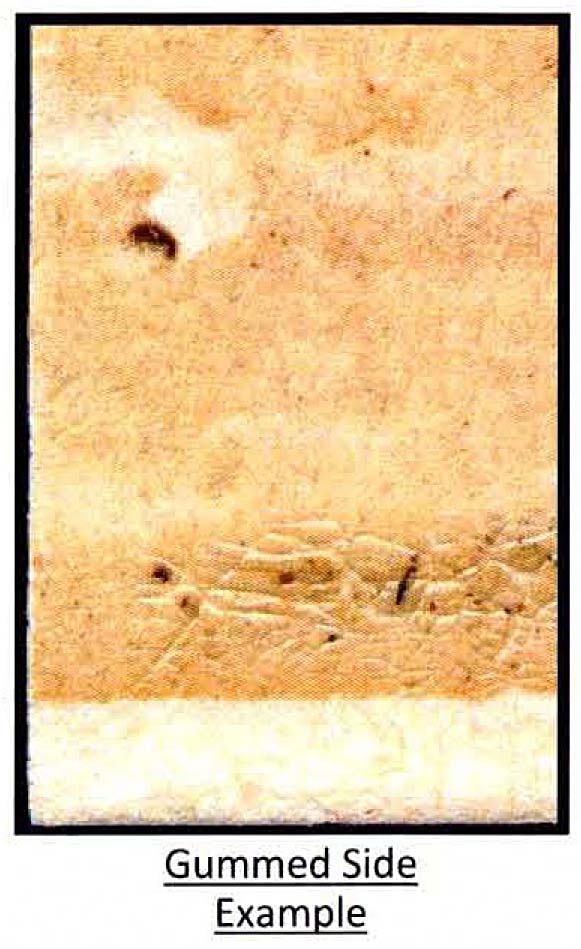 All of the NRZU national issues are on unwatermarked paper, and were lithographed by 'Litografia LAM' of Uzhhorod, Carpatho-Ukraine. The stamp's printed image is about 37mm-by-24mm. Some catalogues describe its colour as 'carmine', others as 'red'. The imperforate version stamps are often seen 'irregularly' cut apart, while the perforate versions (11½), completed through the 'comb-punch' process are rather roughly finished. While this perhaps says something about the quality of the thin unbleached paper, the result is a 'premium' for better perforate examples. The dextrin gum was hand applied to all NRZU national issues, also speaking to 'quality issues'. For example, wetter applications have resulted in 'gum penetration', mottling and curling, while thicker applications witness the gum 'browning' more quickly, and crackling. Thus, the collector might want to 'keep an eye out' in order to upgrade. There is one plate number for all three of this set's issues, '1', and a second for the 200f (2P) value, 'lA'. These numbers are on separate fields along with a 'socialist star' at the bottom-left of the pane, except for the 200f’s plate 1A which is between the two lower-right stamps. These issues also have separate fields solely with the star. As such, a combination of the stamp field attached to the various plate-number-star fields are desirable. Finally, the 60f value includes a variety called 'type-II', shifted-to-the-right letter 'П' in the word 'ПОШТА' (Poshta).
All of the NRZU national issues are on unwatermarked paper, and were lithographed by 'Litografia LAM' of Uzhhorod, Carpatho-Ukraine. The stamp's printed image is about 37mm-by-24mm. Some catalogues describe its colour as 'carmine', others as 'red'. The imperforate version stamps are often seen 'irregularly' cut apart, while the perforate versions (11½), completed through the 'comb-punch' process are rather roughly finished. While this perhaps says something about the quality of the thin unbleached paper, the result is a 'premium' for better perforate examples. The dextrin gum was hand applied to all NRZU national issues, also speaking to 'quality issues'. For example, wetter applications have resulted in 'gum penetration', mottling and curling, while thicker applications witness the gum 'browning' more quickly, and crackling. Thus, the collector might want to 'keep an eye out' in order to upgrade. There is one plate number for all three of this set's issues, '1', and a second for the 200f (2P) value, 'lA'. These numbers are on separate fields along with a 'socialist star' at the bottom-left of the pane, except for the 200f’s plate 1A which is between the two lower-right stamps. These issues also have separate fields solely with the star. As such, a combination of the stamp field attached to the various plate-number-star fields are desirable. Finally, the 60f value includes a variety called 'type-II', shifted-to-the-right letter 'П' in the word 'ПОШТА' (Poshta).
DOMESTIC LETTER RATE: 60 fillér
The scenes specific to both the 100f and 200f values depict the 'chain breaker' theme, so typical to the design of some early 1920s soviet stamps, symbolizing attainment of 'freedom'. Like the 60f value, the printed image on these two stamps are about 37mm-by-24mm. Some catalogues describe the only colours as blue and blue-and-red respectively. Other catalogues detail colour varieties for the 100f, two of which are shown below by comparing the imperforate to the perforate, and lack of alignment varieties of the two colours on the 200f pair as also shown below. There are no design varieties additional to those stamps below. Note the abbreviated name 'Т.Мошк' to the lower-left of the stamp image, standing for Litografia LAM's designer and plater 'T. Moshkovich'. Perforates are 11½. (Quantities quoted below are for singles only.)
INTERNATIONAL POST CARD RATE of 100 filler (1 Pengő), and INTERNATIONAL LETTER RATE of 200 filler (2 Pengő)
SECOND EDITION NRZU NATIONAL SET OF SIX VALUES (TWELVE STAMPS TOTAL) RELEASED LATE JUNE·1945
Local Carpatho-Ukrainian scenery is replaced with USSR icons, as the stamps for all values now show the star of socialism, and the hammer and sickle of communism inserted within. Value errors exist specific to the highest two values (see following page), and all values have colour variations, 'gutter pair' and 'gutter pair plate number 1 and 1A' combinations. Consult specialist catalogues. Printed images 18mm-by-22mm. Perforates 11½. (Quantities quoted below are for singles only.)
SECOND EDITION NRZU NATIONAL PLATING ERRORS OF THE TWO HIGH-VALUE PERFORATE STAMPS FROM THE SET OF SIX
The 'plating error variety' for the two highest of these values are rather interesting in detail. Of course with two plates, one for the stamp image and the other for the value, as many as three sheets (each sheet bore two panes-of-100 side-by-side) of the '100f' and as many as two sheets of the '200f’ values had their plates 'mixed up'. Was this an intentional philatelic contrivance, a simple mistake, or, as may be indicated by the reverse views where both show heavy offset, did this mix-up occur due to stickiness of the wet-inked paper? Catalogues that list these two stamps differ in stated quantities produced, noting either 200 of each, or 600 for the 100f and 400 for the 200f. Either way, quite scarce! For further information, consult specialist catalogues. Printed images 18mm-by-22mm. Perforate 11½.
INTERNATIONAL POSTCARD 1 Pengő RATE, and INTERNATIONAL LEDER 2 Pengő RATE
THIRD EDITION NRZU NATIONAL SET OF TWO VALUES (FOUR STAMPS TOTAL) RELEASED SEPTEMBER 1945
Another set of low values rates were again issued about three months after the previous set's issues. They are identical to the earlier versions, except for the addition of the year 1945, '19' and '45' to either side of the value tablet. These issues came just a couple of months before Carpatho-Ukraine's stamps became invalid, which is thus reflected in both the quantities produced, as well as the relative availability, or rather lack thereof, of properly posted covers bearing these stamps. While these rates are correctly referred to as 'low values', they also completed a role as 'make-up rates', in combination with each other or others, toward any higher total franking that may have been required for a posting. Consult a specialist catalogue if you are interested in the 'combinations varieties' and colour variations that exist. Perforates are 11½. (Quantities quoted below are for singles only.)
See the scan that is another demonstration to the matter of 'quality', as demonstrated by the bleeding of the image's ink through the paper, and the irregular application of the dextrin gum. A magnified scan of the bottom quarter of the stamp image, shows '1945'.
LOW VALUES 10 fillér and 20 fillér RATES
RELATED MATTERS: STAMPS
The National Assembly Commemorative of 1939
Relative to this stamp, we expand upon two matters that have been briefly addressed. The first is that this issue is 'almost identical to a October 28th, 1928 orange-red release by Czechoslovakia which, ironically, commemorated the 'Tenth Anniversary of Czechoslovak Independence'. Going into historical detail, ...
"After the collapse af the Austro-Hungarian Empire in 1918, Carpatho-Ukrainians were persuaded by the promise of territorial autonomy to join the newly created Czech Slovak Republic as the Carpathian Province. The Munich Conference of September 1938 provided Germany with the opportunity to annex German-populated Czech districts of Bohemia and Moravia (the Sudeten land). A few months later, Hungary allied itself with Germany. By March 1939, the Czech-Slovak Republic was dismembered into the German Protectorate of Bohemia-Moravia and the Slovak State. Reports and rumors circulated that the Carpathian Province would hold a National Assembly. This Assembly was postponed several times until the evening of March 14th, 1939, when the independence of Carpotho-Ukraine was announced with Khust as its capital. The next day, a postage stamp inscribed 'Karpatska Ukraina', intended for use within the province but never released [by the Czech-Slovak Republic], was called into service by presidential decree [of Carpatho-Ukraine]. Independence was short-lived and within a few hours Hungarian troops captured Khust and, despite resistance, eventually the entire Province. While initially intended as a Czech-Slovakian regional issue, the circumstances of its release render it the first Carpatho-Ukrainian stamp issue."3
The second matter is that 'a keen eye will detect broad horizontal 'scoring'. These lines, 5½mm apart, are the result of rotary press printing. The sheets onto which the stamps were printed came pre-gummed, and would curl when the press cylinder applied the moist ink. Scoring the sheets limited curl.
Examples of Unissued Stamps for Carpatho-Ukraine Territory 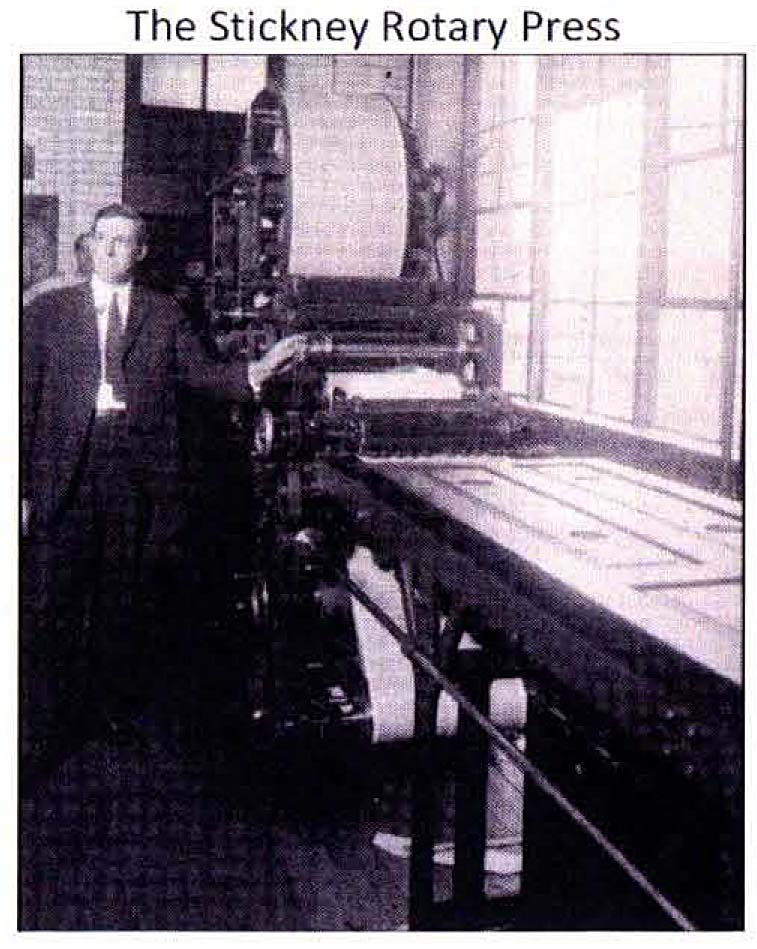
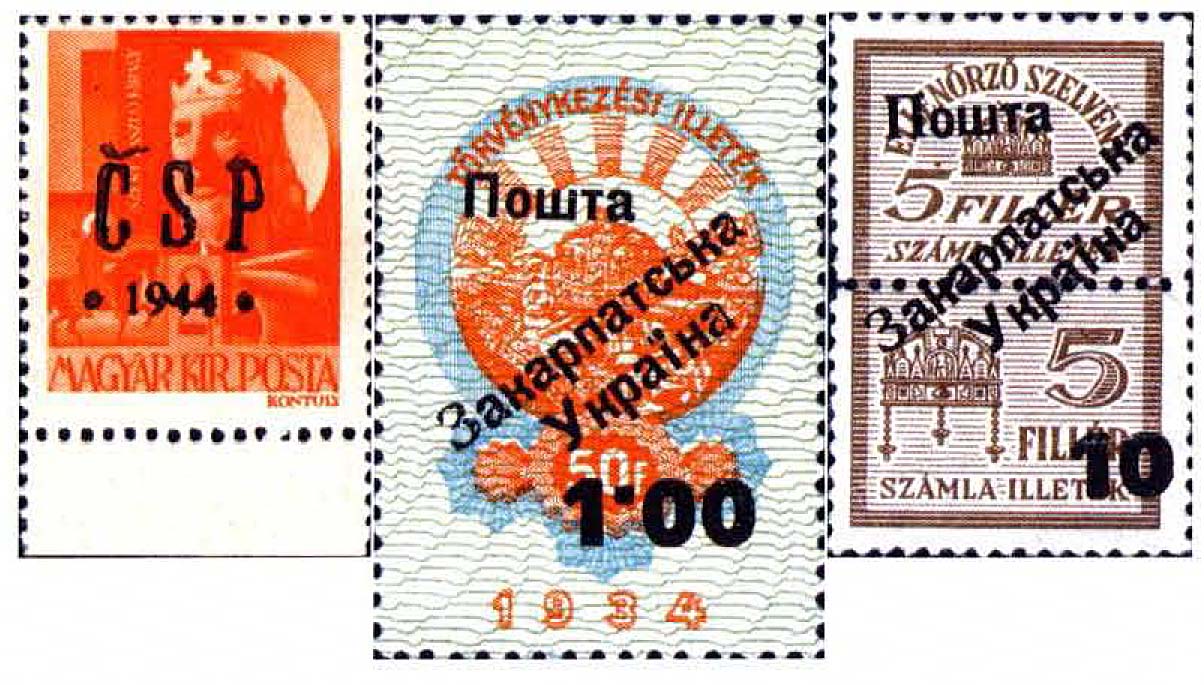 The history as to the unissued stamps of the 'restored Czech' government in Carpatho-Ukraine has already been examined. However there were other unissued Carpatho-Ukrainian overprints, notably large NRZU 'on-revenues'. The small on-revenues were released, but large formats were not, likely due to a combination of concerns, hesitation in using revenues to begin with, but further, these examples being too large or awkward. Consult specialist texts for a complete list of this material.
The history as to the unissued stamps of the 'restored Czech' government in Carpatho-Ukraine has already been examined. However there were other unissued Carpatho-Ukrainian overprints, notably large NRZU 'on-revenues'. The small on-revenues were released, but large formats were not, likely due to a combination of concerns, hesitation in using revenues to begin with, but further, these examples being too large or awkward. Consult specialist texts for a complete list of this material.
The ČSP example is one of 40 former Hungarian stamps overprinted as such that would have served a restored Czechoslovakian government in Carpatho-Ukraine had it lasted longer. The second and third scans show two examples of NRZU revenues that were not used (though philatelic usage exists), these being two of 52 such revenues. Some are very minimal in quantities.
RELATED MATTERS: FANTASY STAMPS, AND PHILATELIC SOUVENIRS
Berehove, Mukachiv, Teresva, and Yasinia
Four overprint 'creations' can be found that were not formally the result of any governmental entity. These are most likely akin to 'basement creations' of star-struck ' loyalists' caught up in a wave of national or regional pride as their primary reason. That some of these creations may be found tied on cover are no less valid than those of current Ukraine's contemporary provisional fantasies that were also cancelled through favour by sympathetic post office employees. Nevertheless, the symbolism of these Carpatho-Ukrainian creations has great historical meaning that should not be discounted. Each of the following are but one of several overprinted stamps per overprint type.
The first item, a post card, was a commemorative creation that featured the National Assembly stamp as well as official cancellations of Carpatho-Ukraine on March 15th, 1939. The second item, a postal card, bears two of the NRZU's Second-Edition stamps circa June1945.
RELATED MATTERS: A SUMMARY OF STAMP TOTALS
Timeline Summary
Soviet troops and a restored Czech government seated in Khust quickly assumed the role of 'security' and 'leadership', after Hungary relinquished their rule over Carpatho-Ukraine through defeat and retreat during October 1944. Shortly after this, the restored Czech government was replaced, by the NRZU seated in Uzhhorod. Carpatho-Ukraine's relatively brief first tariff era piggybacked on rates that were established during the last months of Hungarian rule. It more or less fit a role of 'caretaker' rates until the new nation consolidated its efforts. These rates seemed better satisfied through the many remnant-postal-cards (some very quickly to become overprinted) that Hungary left behind along with stamps. Further, and as well, use of Hungarian stamps satisfying tariff-1 rates through their face values were honoured for a brief period, while the post offices stock of those stamps began to be returned for overprinting starting January 3rd, 1945.
To sum, a few months later, March 1st, 1945 saw Carpatho-Ukraine introduce their own unique set of postal fees. Meanwhile, one month prior to this, February 10th saw an initial but limited number of overprints in 'anticipation' of these new rates, 27 such stamps being released mainly in the Uzhhorod area, the seat of government for the NRZU. As we know, these overprints were completed on left-behind Hungarian stamps, but this release was only the beginning. A second such group of overprinted stamps release occurred about five weeks later on March 20th, witnessing the earlier overprints releases greatly supplemented with a further 115 new issues across the nation. Finally, locally created original Carpatho-Ukrainian issues began to be released starting May 1st, 1945. Unfortunately, on November 15th, 1945, this small nation was absorbed by the USSR, and Carpatho-Ukraine's stamps were replaced with those of this now-former soviet empire.
SOME COVERS POSTED IN CARPATHO-UKRAINE DURING THE AUSTRIAN ERA 1786 to 1867
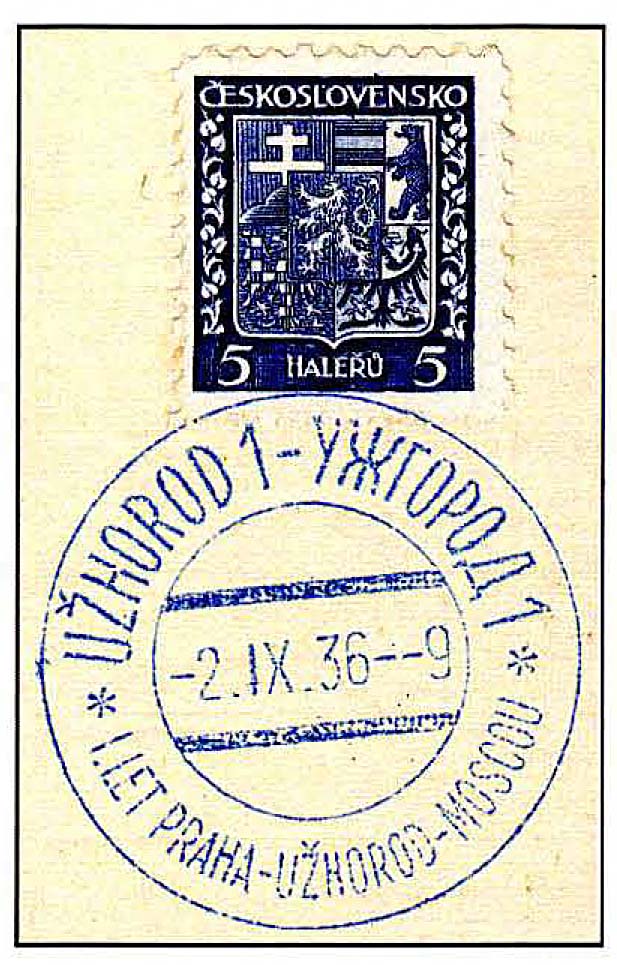 In 1929, Uzhhorod saw an airport built within its boundaries. A 'first flight' event that commemorated the occasion became an annual affair (though the odd year was missed), by the end of which nine such events had taken place. The last took place in 1938. The eighth flight that took place during 1936 resulted in a set-of-four. To the right is the Uzhhorod cancel example. (All of these are listed on pages 105 to 107 in the Verleg text.) Stamp released on February 1, 1931.
In 1929, Uzhhorod saw an airport built within its boundaries. A 'first flight' event that commemorated the occasion became an annual affair (though the odd year was missed), by the end of which nine such events had taken place. The last took place in 1938. The eighth flight that took place during 1936 resulted in a set-of-four. To the right is the Uzhhorod cancel example. (All of these are listed on pages 105 to 107 in the Verleg text.) Stamp released on February 1, 1931.
HUNGARY POSTAL CARDS USED IN CARPATHO-UKRAINE (CU) DURING THE SECOND HUNGARIAN ERA 1938 to 1944, AND CU OVERPRINT
THE SECOND CZECHOSLOVAK ERA, OCTOBER 1944 to MARCH 1945
COMMEMORATIONS: A COVER, AND TWO PIECES
These three items are 'ex-Cronin'. The following passage comes from the write-up within a part of a Carpatho-Ukraine-related exhibit that Andrew Cronin completed:
"Cover from Chust to Tacevo with the Special Cancellation of the Chust Delegation's Courier Service: The Chust Delegation established a courier service primarily for carrying official mail. A certain amount of local mail was also carried for which Hungarian stamps were used. A special cancelling device was prepared with the words 'Republic of Czechoslovakia / Chust / Post of the Liberated Territories '. This cancellation was red, and only three dates are known, November 8, 13, and 14, 1944. Since this was essentially a private post, letters carried had as a rule no ather markings to indicate whether they were actually carried by this service. Other special cancellers were used in some other localities under the control of the Delegation. On December 4, 1944, stamps of Hungary [were] overprinted by order of the Delegation with 'ČSP 1944·' ... . "
The cancel below measures properly at 38½mm in diameter. However beware of 'counterfeits' that measure 42mm. (This is mentioned in the Verleg text on page 154.)
RELATED MATTER: COVERS
Mailing of 15 March 1939 Properly Posted
The following is a properly posted mailing sent from Khust, Carpatho-Ukraine to Okfisky, Czechoslovakia. The stamp's 3-Korony face value satisfied the in-era regular weight domestic letter rate (1 Korona), plus the registry fee (2 Korony). Its back stamp shows that the letter was received in Okfisky the following 24th, taking nine days.
Carpatho-Ukraine During the Year 1945
All of the stamps were completed by one of two Carpatho-Ukrainian printing firms, these being 'Litographia Lam' and 'Főldesi'. About 44% of the stamps bore values specifically for local mail, while 26½% were tailored for foreign mail. The rest were low-value rates fitting a role as make-up stamps, or high value definitives for oversized and/or overweight packages. All postage, cancels and etiquette clearly show Ukrainian as the only official language in this era. The following examples demonstrate this.
CREDITS AND ACKNOWLEDGEMENTS
Sourcing Acknowledgements:
The following references have been integral to this text, (preceded by the acronym that may have been used to represent them herein):
Mi- 'Michel Europa-Katalog Ost 1998/99', ©1998 Schwaneberger Verlag GmbH, Muthmannstraße 4,080939, Munchen, isbn 3878582978, 'Karpaten-Ukraine' page 387;
Ca- 'Український Філателіст - Ukrainian Philatelist, Semiannual Journal of the Ukrainian Philatelic and Numismatic Society, Special Issue on Carpatho-Ukraine', Vol·53 #2 (94), ©2005, published by the Ukrainian Philatelic and Numismatic Society and Ukrainian Philatelic Resources (UPR). Springfield Virginia, issn 01986252, isbn 188958116X; Authors of this Ukrainian Philatelist 'special issue on Carpatho-Ukraine' as follows: 'Introduction' by John Roberts; 'An Introduction to the Stamps of Carpatho-Ukraine' 1939 and 1945' by Jay Carrigan and Ingert Kuzych; 'Carpatho-Ukraine: A Catalog of the 1939 and 1945 Issues' by Jay Carrigan; 'Carpatho-Ukrainian Postal Stationery, 1939 and 1945' by Ingert Kuzych and Jay Carrigan; 'The Kolomyia Provisional Postal Cards of 1941' by Ingert Kuzych;
Bu- 'Comprehensive Catalogue of Ukrainian Philately', ©1992 by John Bulat, ©2003 by Irene Bulat and Ann Dunkle, edited by Dominick Prokop Riccio, English translations by Jerry G. Tkachuk and Ann Dunkle, completed by Borys Fessak, Karen Lemiski, and Jerry Tkachuk, photography and cover design by Olech W. Wyslotsky, printed in USA;
BK- 'Carpatho-Ukraine, A Catalog-Checklist', Ukrainian Philatelic Resources No.3, ©1995 by Peter Bylen, published by UPR, Westchester, Illinois, USA;
Ve- 'Carpatho Ukraine, Postal History and Stamps 1786-2000', Monograph No. 21, ©2007, compiled by Ing. J. Verleg (AEP), Vereniging voor Tsjechoslowakije-Filatelie, Netherlands (email link for purchase:
vS- 'Spezialkatalog Karpaten·Ukraine·Спеціальний каталог Закарпатська Україна', ©2000, by G. von Steiden, Druckerei Schmerbeck GmbH, D-84184 Tiefenbach, München.
Credits:
- The italicized passage the introductory page is from the Bulat text page 191;
- For more the watermarks, please see 'Of Watermarks and Vignettes: ...', by Michael Shulewsky, Ukrainian Philatelist No. 102, ©2009, issn'01986252, page 56;
- The italicized passage the concluding page is from 'BK' (listed above). page 3;
- Introductory page 'sepia-enhanced' photo is original to page 114 of Verleg's text;
- Stickney photo: 'The Canadian Philatelist', Mar/Apr 2014, V5 N, issn·00455253, 'Canadian Postage Stamps Printed by the Stickney Rotary Press', by J. Goldberg, page 80;
- The Carpatho-Ukraine map is a refined version of that from 'The Encyclopedia of Ukraine, Volume 1', ©1984, isbn 0802033628, page 368(b);
- Since the author does not own everything that is Carpatho-Ukrainian, the following 78 images of overprinted stamps were lifted from the von Steiden text: 2, 5, 10, 15, 17, 19, 20, 21, 24, 27, 28, 29, 30, 31, 32, 34, 35, 36, 41, 42, 45, 49, 53, 56, 57, 58, 59, 60, 61, 63, 65, 66, 67, 68, 77, 79, 80, 82, 84, 85, 87, 88, 89, 91, 92, 95, 97,98, 100, 102, 104, 107, 108, 109, 110, 111, 114, 115, 117, 118, 122, 125, 126, 127, 129, 130, 134, 137, 138, 140, 141, 142, and 143; all five fantasy stamps; The following 'Covers' images were lifted from the von Steiden text: 2, 3, 4, 5, 6, 7, 8, 11, 14, and 15;
- The following 'Covers' images were lifted from the Verleg text: 1,9, and 10;
- Mr. Jay Carrigan was both a member the UPNS for several years as well a gold-medal winning exhibitor of Carpatho-Ukraine. His expertise to this genre is well are differences for any issue from one catalogue to another, the listed information in Journal 94 by Carrigan (Ca) been the final default.
Philosophy:
The priority of the numerical sequence herein for these stamps attempts to reflect their release by the Carpatho-Ukraine government, with the second priority being the stamp's original value total that was over-ridden. Inconsequential to the order of stamps in this list was prior stamp context (definitive, commemorative, semi-postal, postage due, revenue), release date of another country, and any grouping originally released as a 'set' by another nation. They are now Carpatho-Ukraine's stamps issued for their territory.
TEXTS FROM CREDITS
The Michel text includes the most comprehensive list of Carpatho-Ukrainian stamps by an internationally renowned 'non-specialized' catalogue; The Bulat textbook includes the most comprehensive list of all Ukrainian stamps, including Carpatho-Ukraine, by a Ukrainian renowned 'non-specialized' catalogue; The journal directly above includes the most comprehensive listing of Carpatho-Ukrainian stamps by a Ukrainian renowned's pecialized' group. It is specific to the point of listing every issue and variety, including, within the various specialty groups, watermark differences, font-style varieties, issued 'values mistakes' stamps, essays/proofs, and unissued stamps (large-format or 'difficult' revenues).
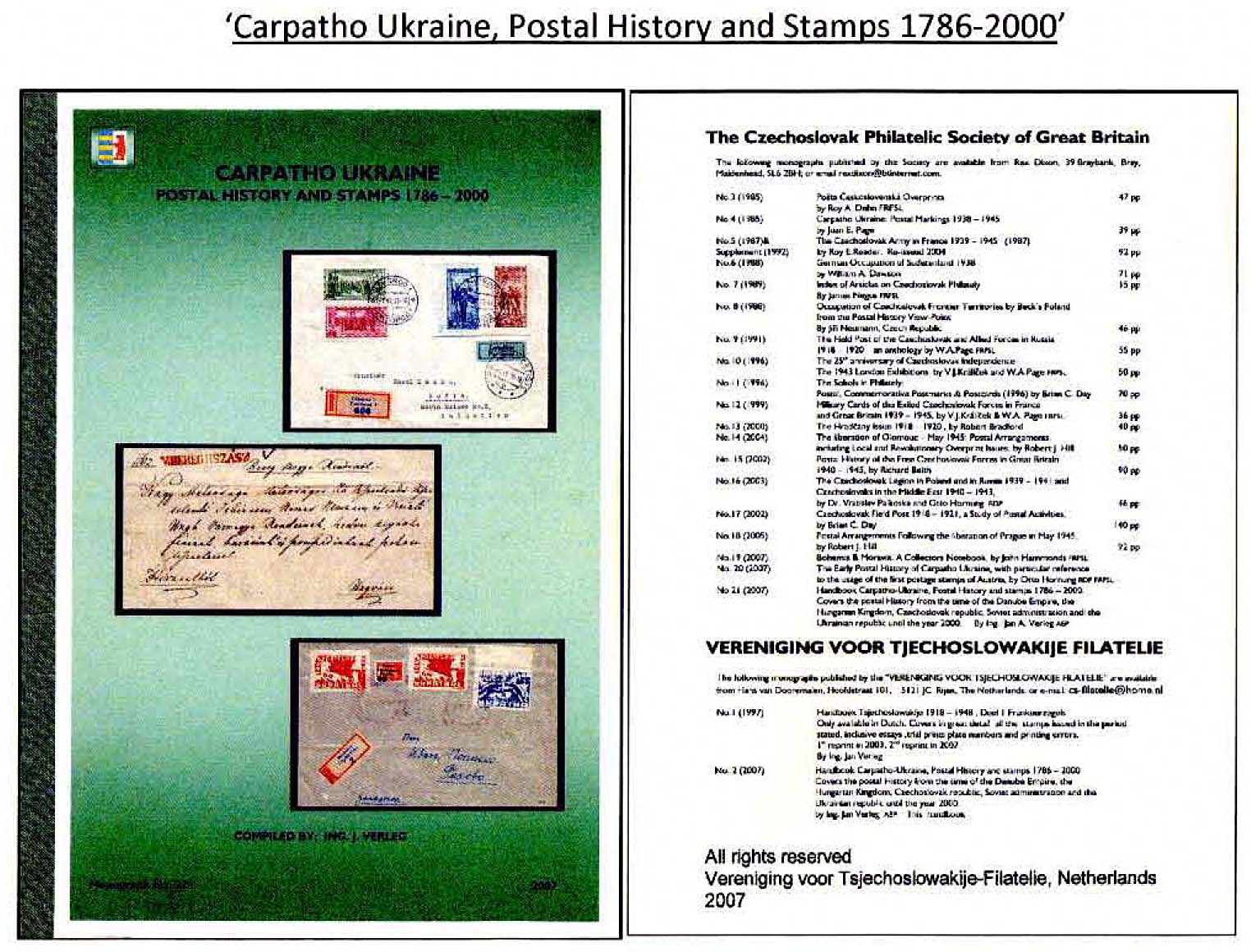
The Bylen catalog, including a comprehensive list of Carpatho-Ukrainian stamps within a Ukrainian renowned 'specialized' catalogue, was the 'Ukrainian Philatelic Resources' (UPR) and Ukrainian Philatelic and Numismatics Society' (UPNS) checklist' of its day. Bylen is a long-time UPNS member, and at the time of this text's completion, he was UPNS Vice·President for USA;
Finally, a book in colour! This von Steiden 'specialized' text is written in German and Ukrainian. It is beautifully illustrated and layed out, including stamps, covers, essays/proofs, and most all of the varieties noted in the Carrigan journal. Only 1000 of these texts were struck! Until recently, Von Steiden ws UPNS Vice President for Europe beginning 2004;
The Verleg text directly above is also in colour. This 'specialized' textbook is as comprehensive as the Carrigan journal, including a listing of all varieties, as well as a myriad of covers directly related to the governmental entities that appeared on Carpatho-Ukrainian territory. I find its specific historical timelines and explanations to be exquisite! (The black-and-white page is in fact a compilation of two inner pages.)
For information on availability of society material, check out our website www.upns.org.

